If you’re looking to decorate your garden and home with some beautiful pink flowers, look no further. In this article, we’ll discuss a selection of pink-flowering plants, each with unique shades from soft blush to vibrant fuchsia, that can add color to your garden or home. So, let’s explore the beauty of pink blooms and their potential to enhance your green space.
Coral Bells (Heuchera)
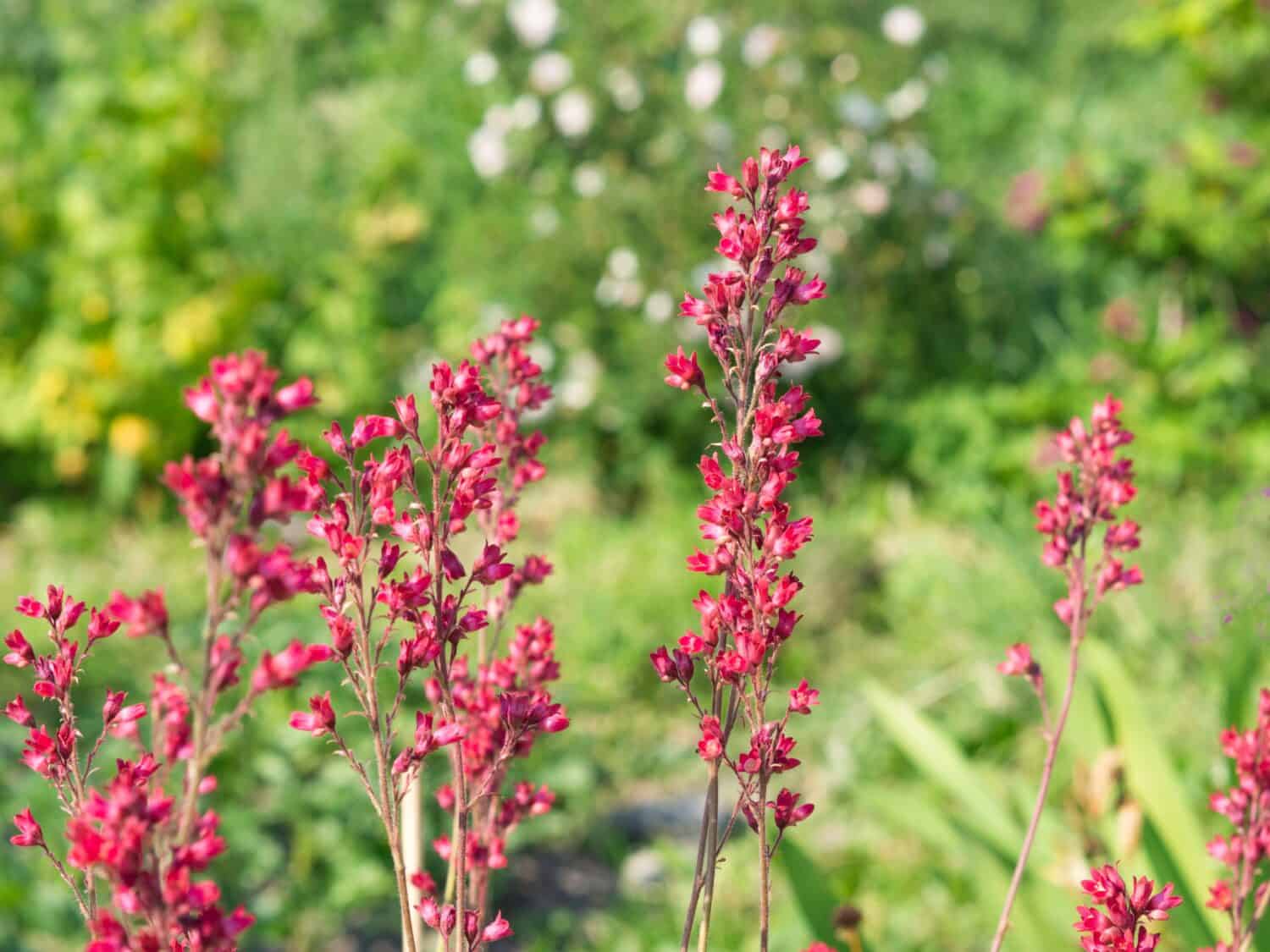
The beautiful bell-shaped flowers of the coral bell plant are a sight to behold.
©mcajan/Shutterstock.com
Coral bells are a versatile perennial plant known for vibrant foliage and delicate bell-shaped flowers that bloom on tall stalks. This plant thrives in partial shade and well-drained soil, needing moderate watering and occasional fertilizing to maintain its colorful charm.
Impatiens (Impatiens)
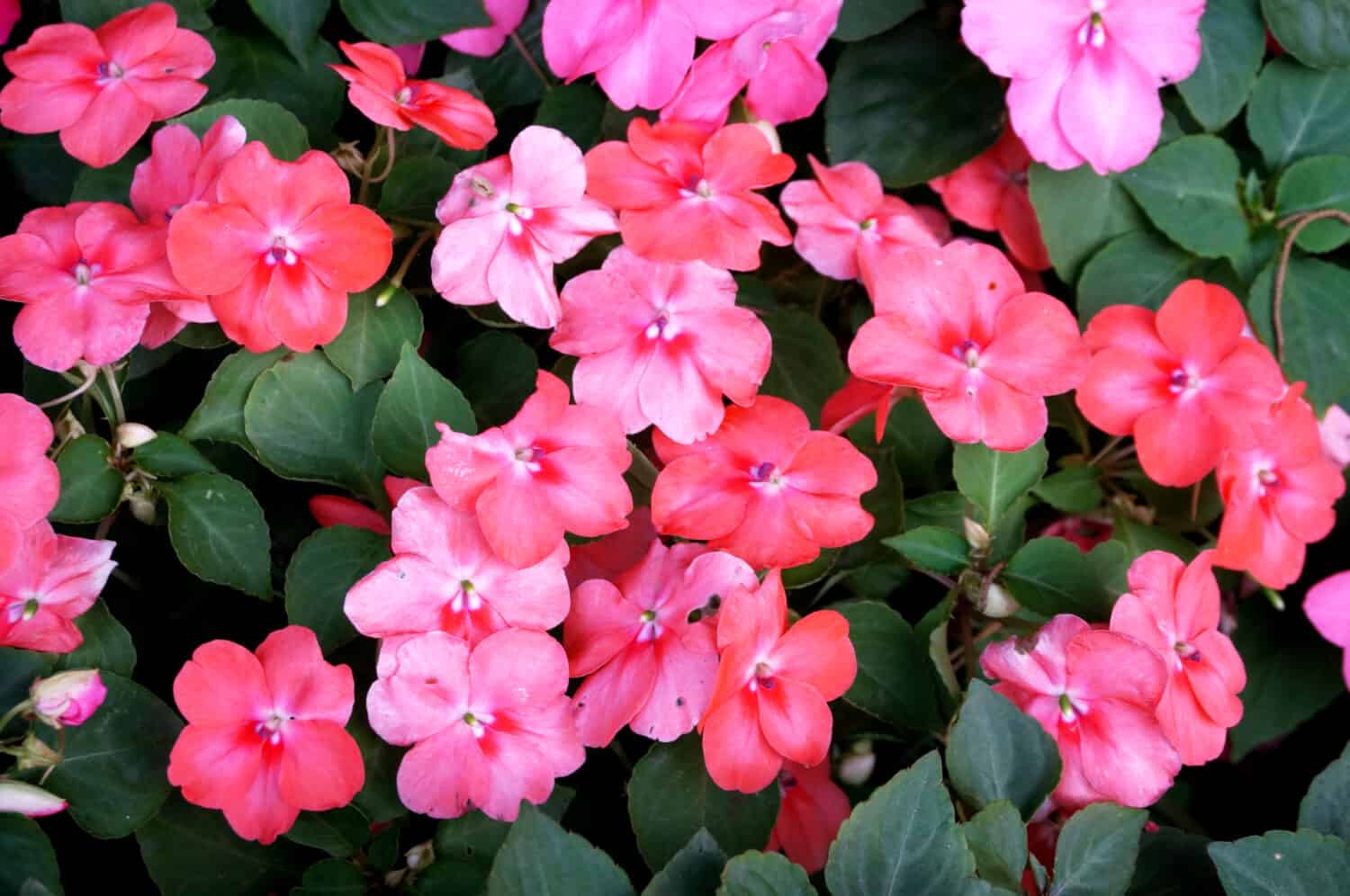
The strikingly pink flowers of the impatiens are a great addition to any garden.
©Aria Pearlilla/Shutterstock.com
Impatiens, often recognized for their brilliant pink blooms, are compact plants that typically reach a height and spread of 1 to 3 feet. They prefer shady to semi-shady locations and consistently moist, well-drained soil, proving to be low maintenance and ideal for beginner gardeners as they require minimal care beyond regular watering.
Lupine (Lupinus)
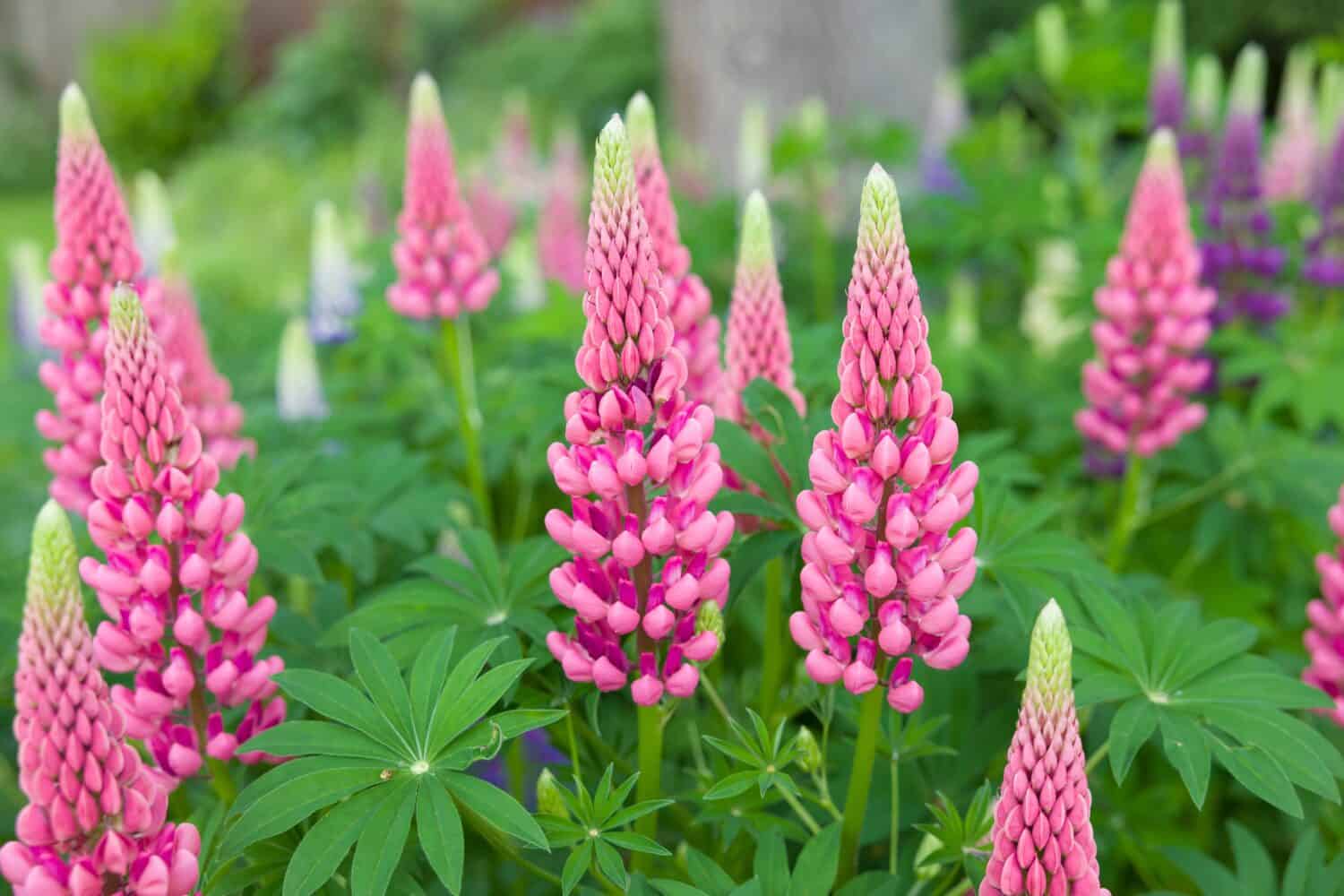
If you’re looking for a unique pink addition to your garden, look no further than the lupine.
©Paul Maguire/Shutterstock.com
Lupine are known for their striking spires of pink flowers, boasting a tall and elegant stature. With their distinctive palmate leaves and pink blossoms, lupines thrive in full sun or partial shade and well-drained soil. They require occasional watering and deadheading to promote continuous blooming throughout the season.
Hyssop (Hyssopus officinalis)
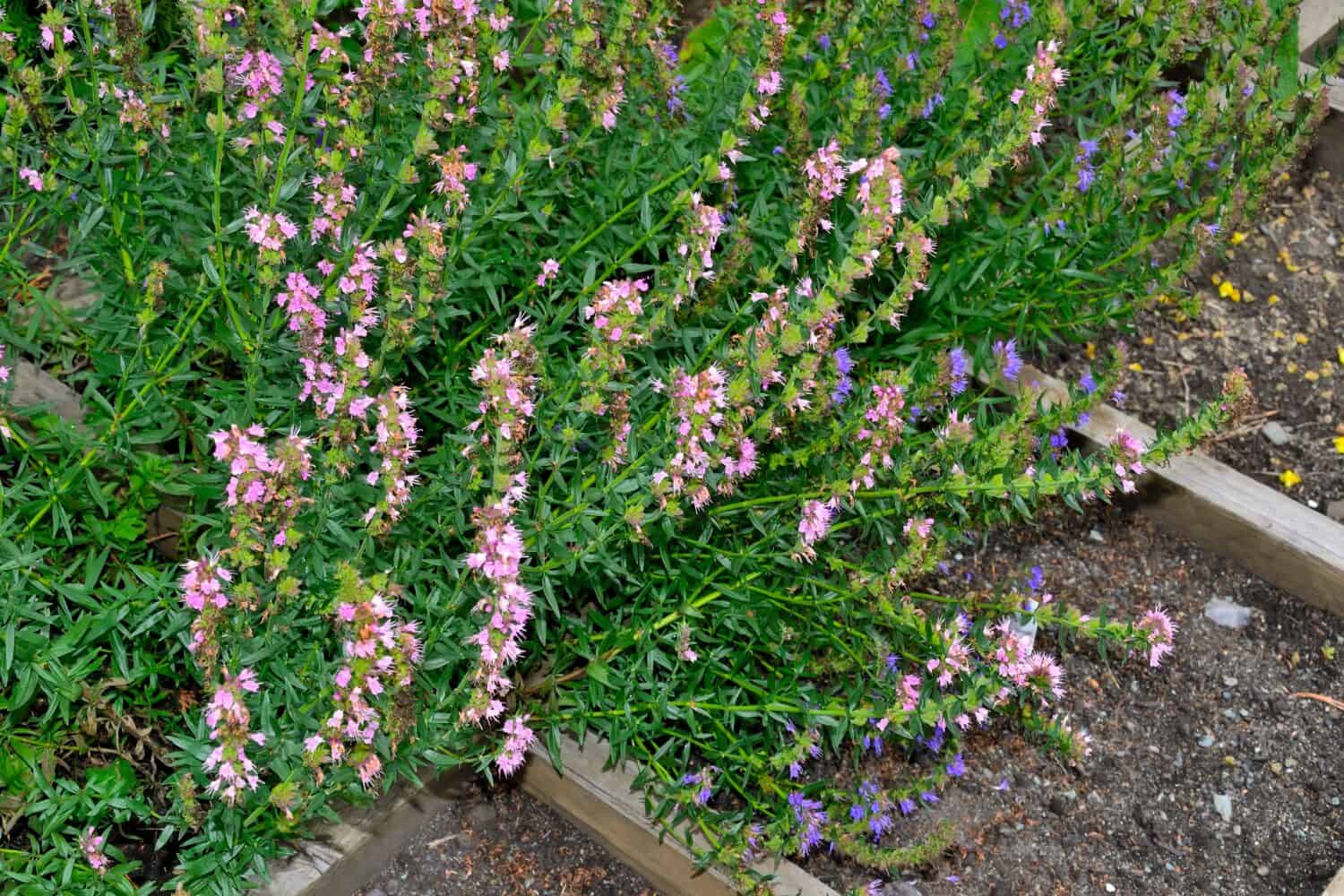
Pruning is required to maintain the shape of the hyssop plant and encourage growth.
©Olga Vasilek/Shutterstock.com
Hyssop is another plant adorned with lovely pink flowers, displaying slender, upright stems with smaller leaves. These compact perennials typically grow to around 2 to 3 feet. Hyssop prefers full sun and well-drained soil, requiring regular watering to moisten the soil. Pruning after the hyssop flowers helps maintain shape and encourages new growth, making it an attractive addition to any garden.
Dahlia (Dahlia)
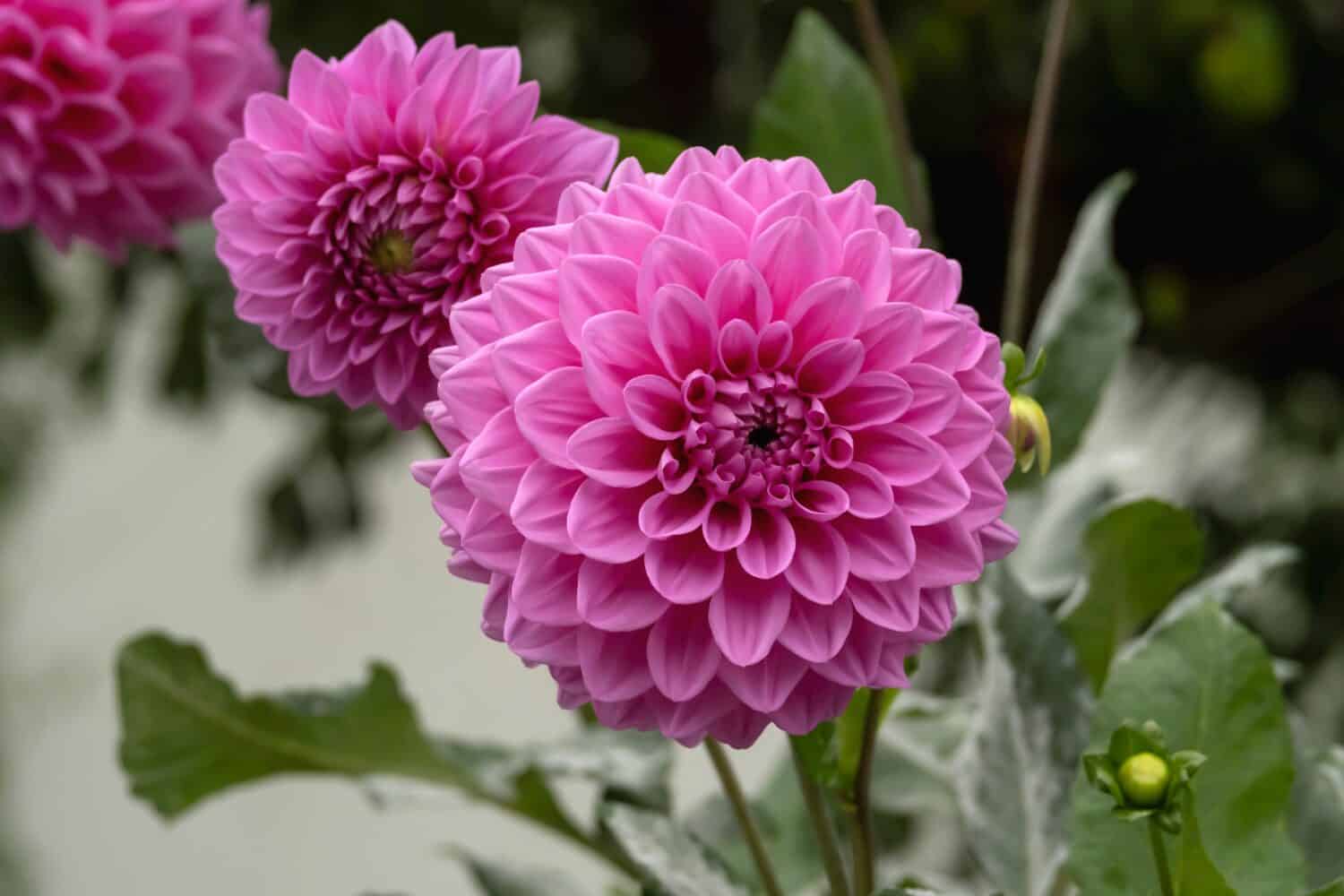
A captivating addition to any garden, dahlias need full sun, well-drained soil, and regular watering.
©jessicahyde/Shutterstock.com
Dahlias, renowned for their showy pink blooms, are flowering plants with diverse shapes and sizes. From compact varieties suitable for containers to tall cultivars reaching 3 to 5 feet, dahlias display lush green foliage as a backdrop to their pink flowers. To care for dahlias, provide them with full sun, well-drained soil, and regular watering. Deadheading old blooms and supporting taller varieties will help ensure continuous blooming and maintain the plant’s upright growth.
Campion (Silene)
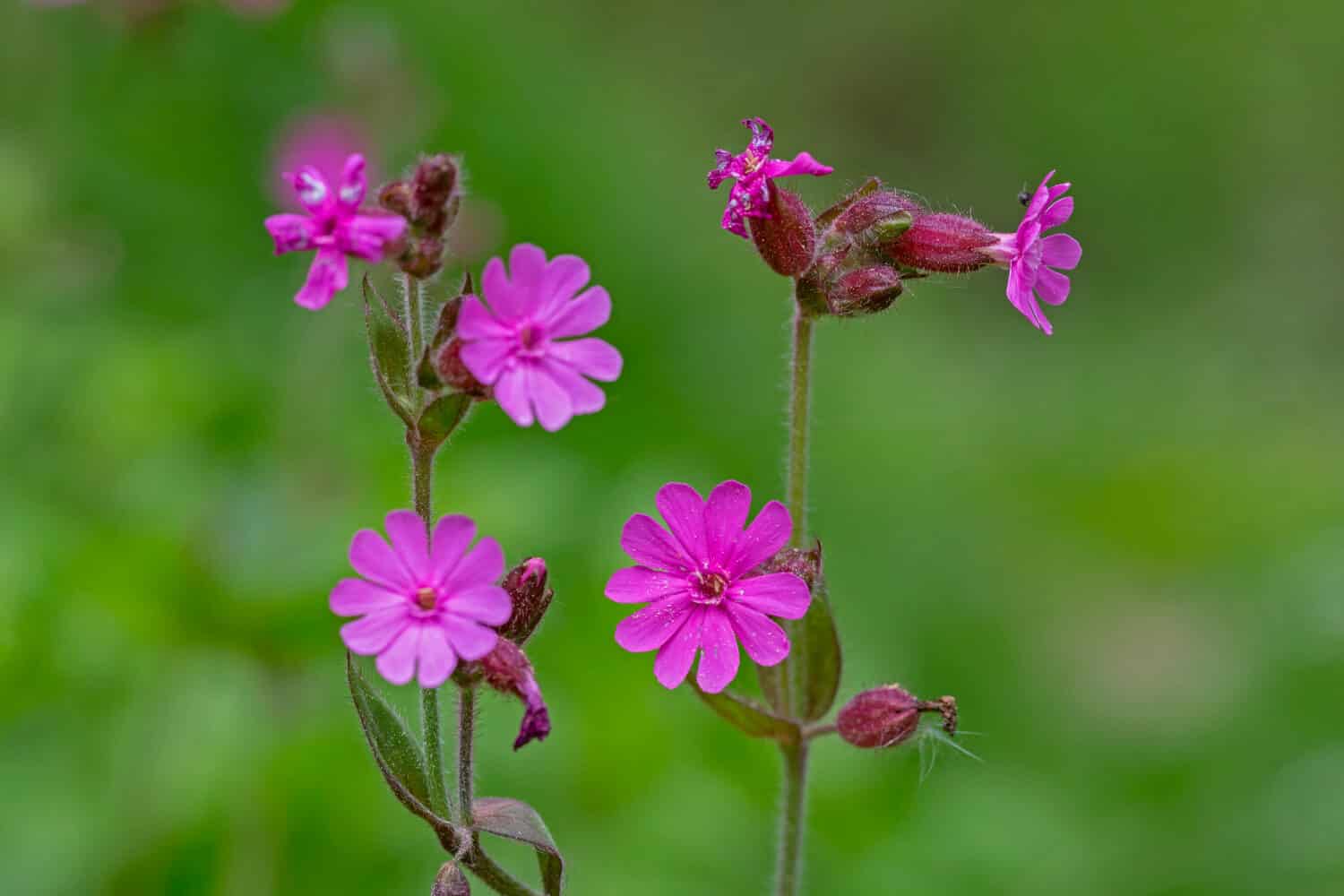
Growing on a slender stem, the campion is a tiny pink perennial.
©Ihor Hvozdetskyi/Shutterstock.com
Campion is a dainty perennial plant with pink flowers that bloom on slender stems, reaching heights of 1 to 2 feet. It thrives in well-drained soil and partial shade or full sun; regular watering will help maintain its gorgeous blooms.
Chrysanthemum (Chrysanthemum)
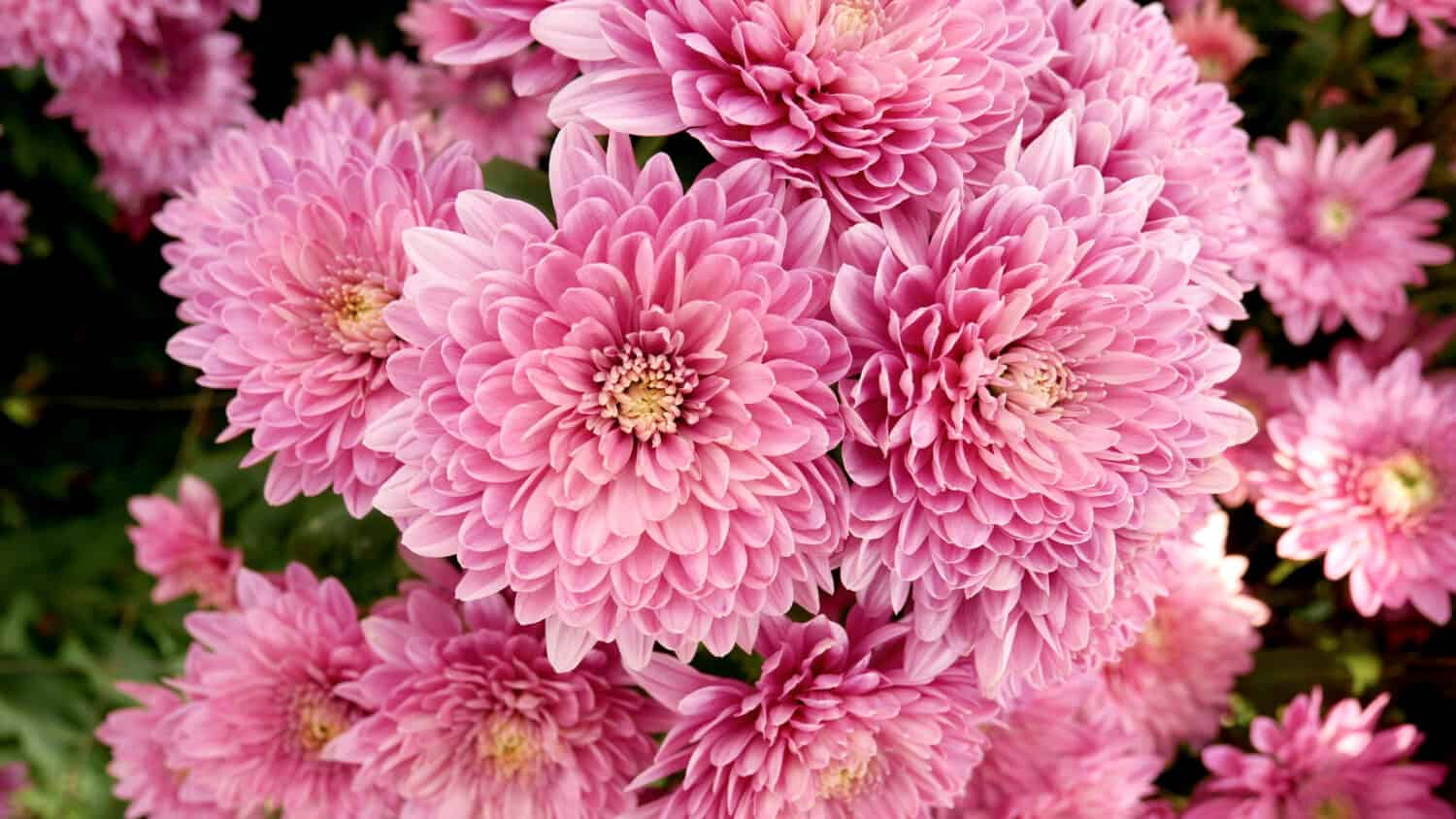
These versatile flowering plants come in various shades of pink.
©StopperOhana/Shutterstock.com
Chrysanthemums are available in various shades of pink and are versatile flowering plants known for their intricate and layered petals. They come in different sizes, ranging from compact mounds to taller varieties, and thrive in well-drained soil with full sun or partial shade. Regular watering and occasional pruning will ensure a healthy and abundant display of pink blossoms.
Astilbe (Astilbe)
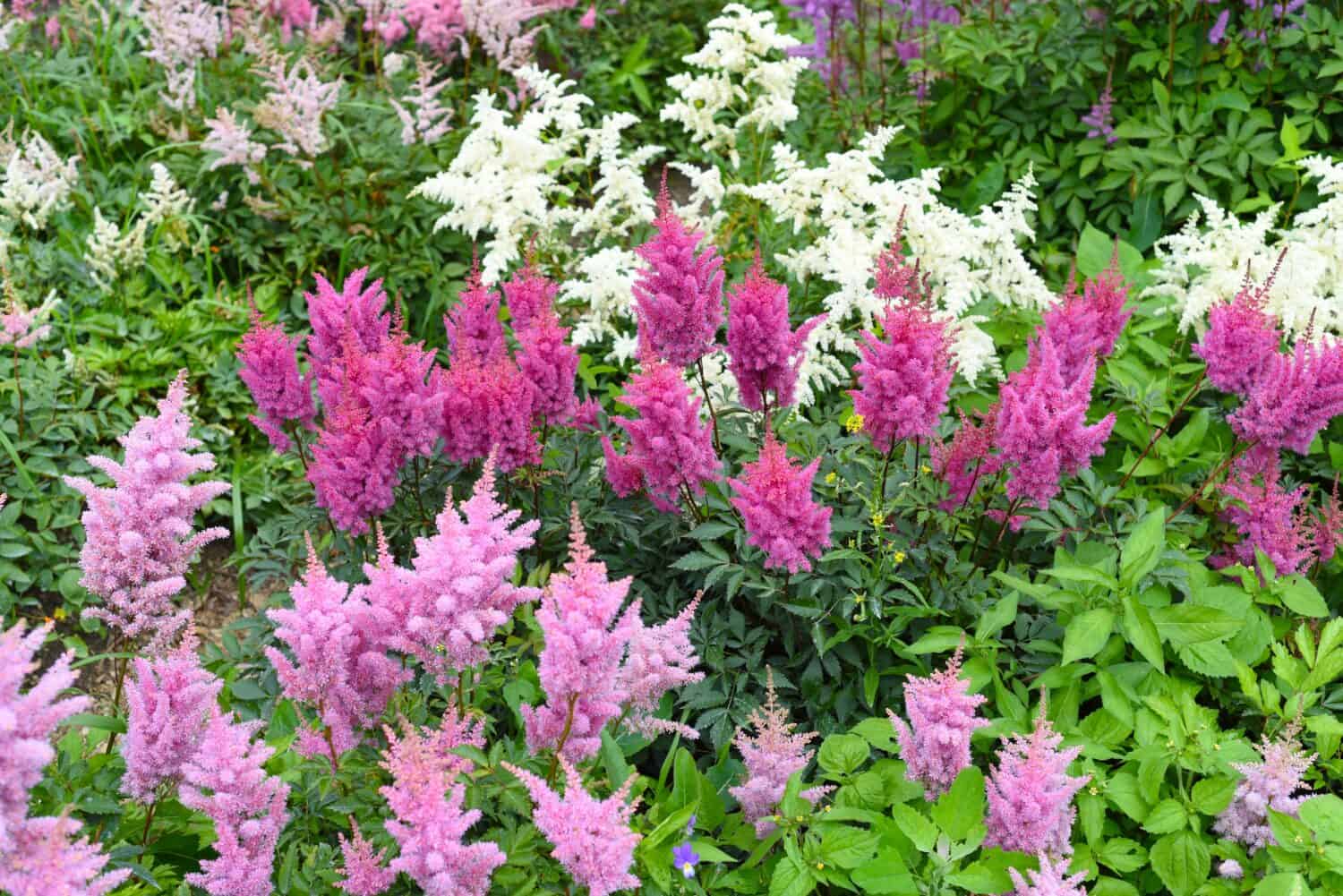
The feathery pink flowers of the astilbe are a perfect choice for a pop of color in a garden.
©Tanya_Terekhina/Shutterstock.com
Astilbe, a perennial with feathery pink flowers, adds color to any garden. Growing to 1 to 3 feet, it prefers moist, well-drained soil and partial shade. Regular watering and mulching around the base of the plant will help maintain its moisture levels.
Zinnia (Zinnia)
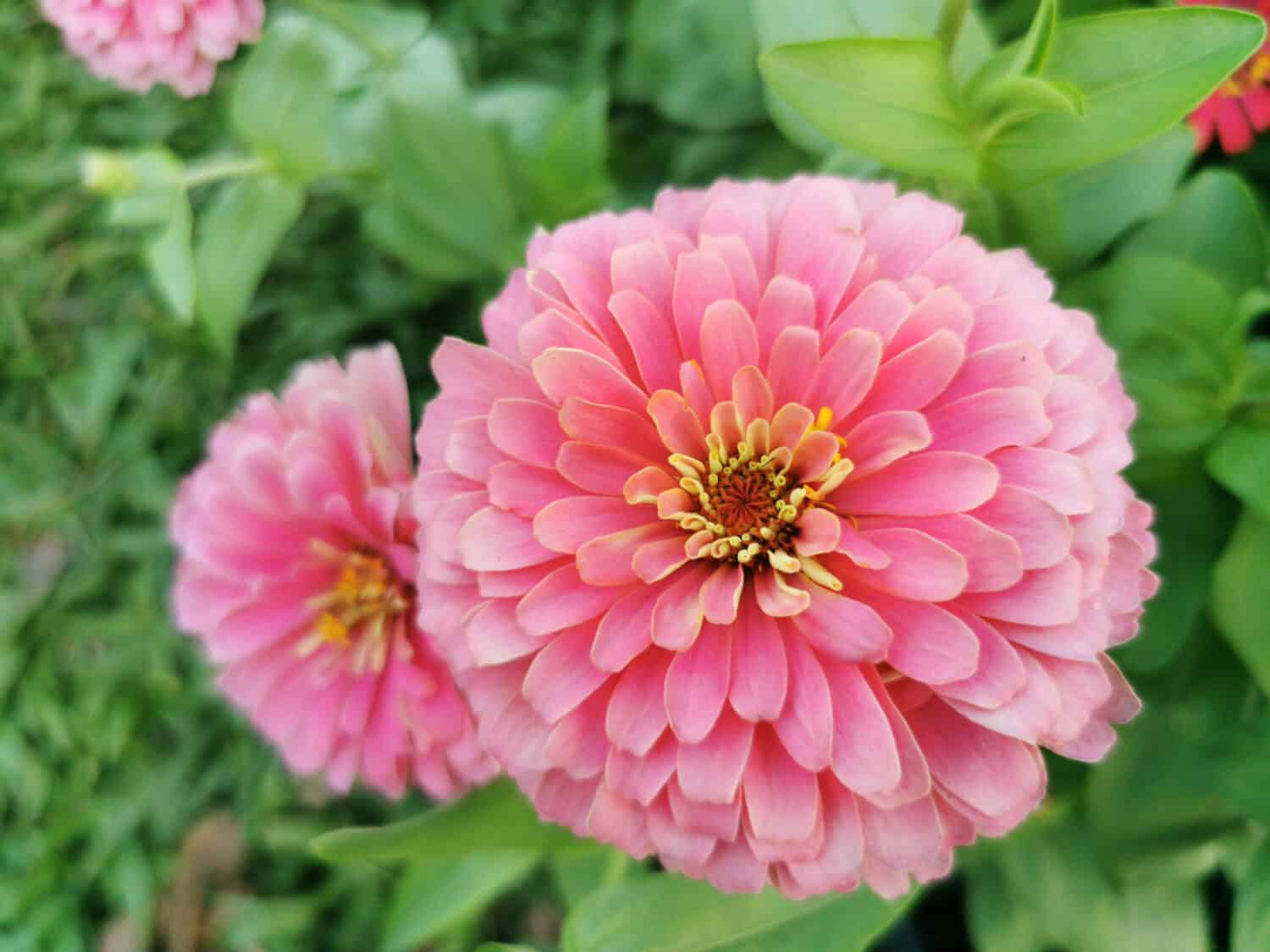
For prolonged blooming of the pink flowers of the zinnia, regular watering and deadheading are essential.
©Sutta kokfai/Shutterstock.com
Zinnias are available in various shades of pink and are vibrant annual plants. They come in different sizes, from compact varieties suitable for pots to taller plants reaching heights of 2 to 3 feet. Zinnias thrive in full sun and well-drained soil, requiring regular watering and deadheading for prolonged blooming.
Anemone (Anemone coronaria)
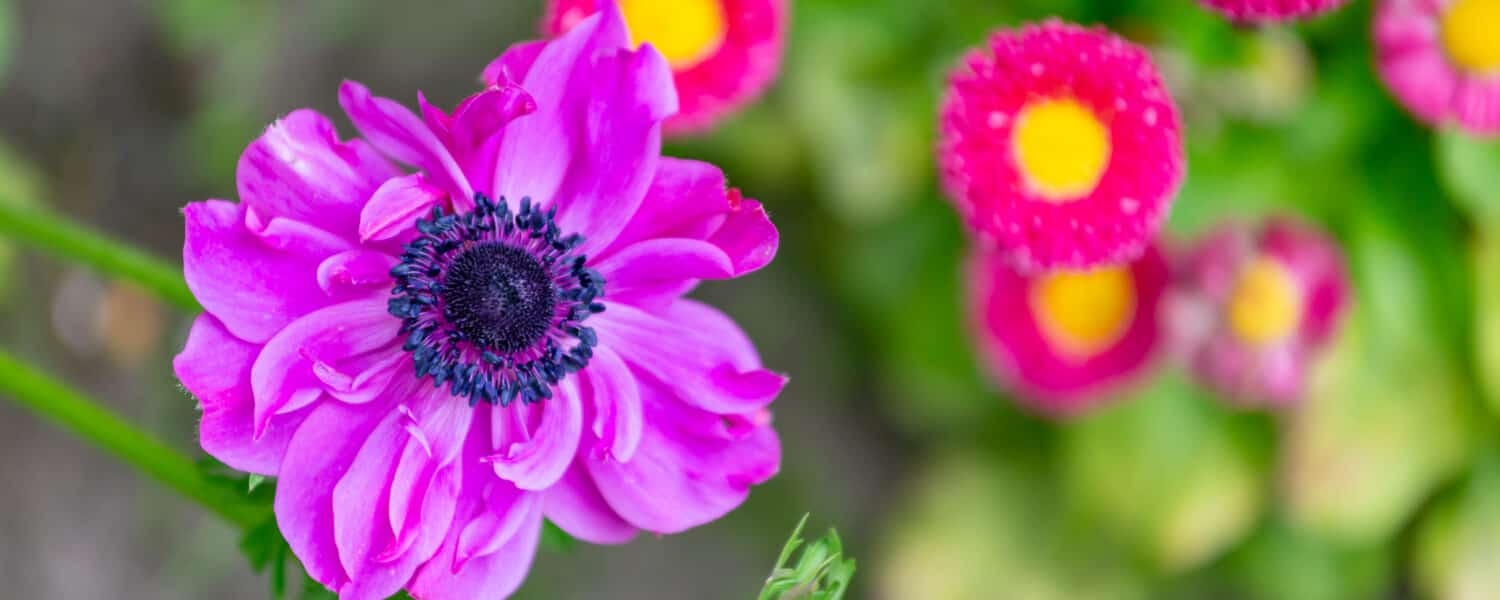
Coming in various colors, including pink, the anemone is delicate.
©INTREEGUE Photography/Shutterstock.com
Anemones, featuring delicate pink flowers with contrasting centers, are perennial plants that grow to heights of 1 to 2 feet. They prefer moist, well-drained soil and partial shade. Regular watering is essential to keep the soil evenly moist for optimal growth.
Tulip (Tulipa)
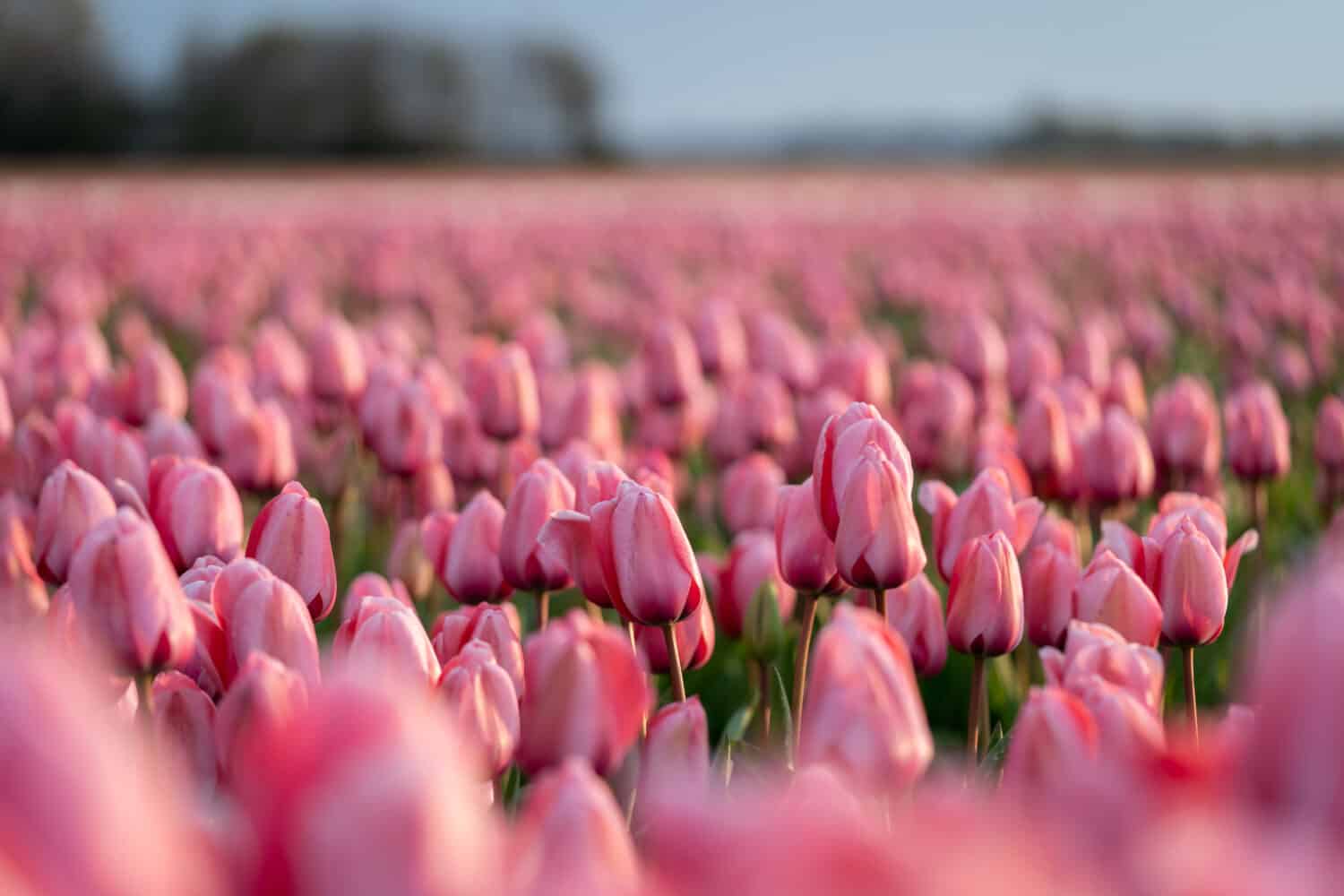
If you’re a tulip lover, pink tulips can add some color to your garden.
©Lizzy Komen/Shutterstock.com
Tulips are a classic spring flower. They come in shades of pink and boast their signature cup-shaped blooms. They vary in size according to the variety, ranging from shorter varieties suitable for bordering gardens to taller ones reaching heights of 1 to 2 feet. Tulips thrive in well-drained soil and prefer full sun to partial shade. Planting them in the fall and providing adequate watering during their growth period will produce vibrant pink blooms in the spring.
Cherry Blossom (Prunus serrulata)
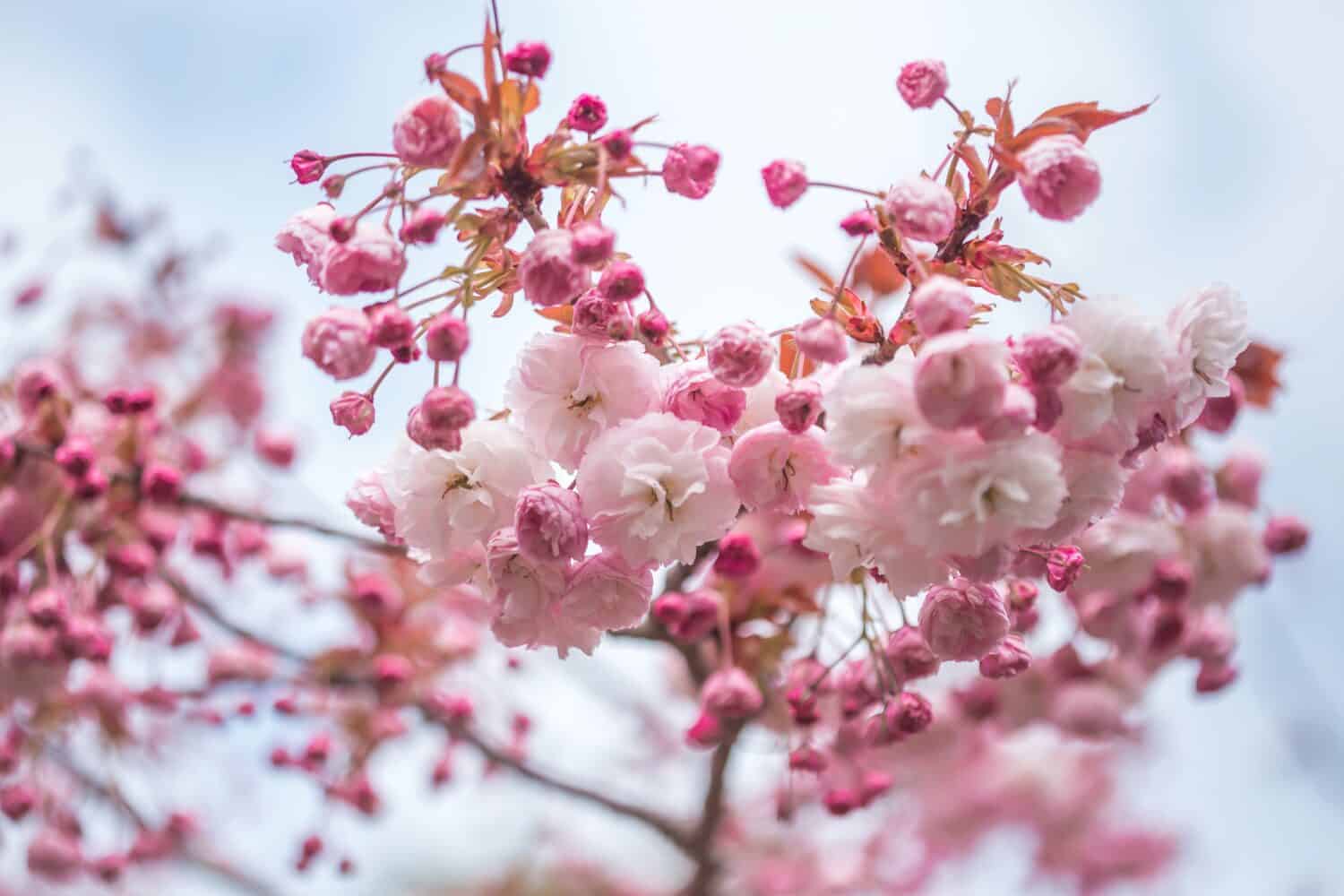
The iconic blooms of the cherry blossom are a popular sight in the spring.
©Marie Shark/Shutterstock.com
Cherry blossoms produce small pink flowers on cherry trees. These iconic blooms can vary in size and shape depending on the specific variety of cherry trees. Cherry trees thrive in well-drained soil and prefer full sun. Proper pruning, watering, and protection from pests and diseases will help ensure healthy growth and a stunning display of pink blossoms in the spring.
Oriental Lily (Lilium orientalis)
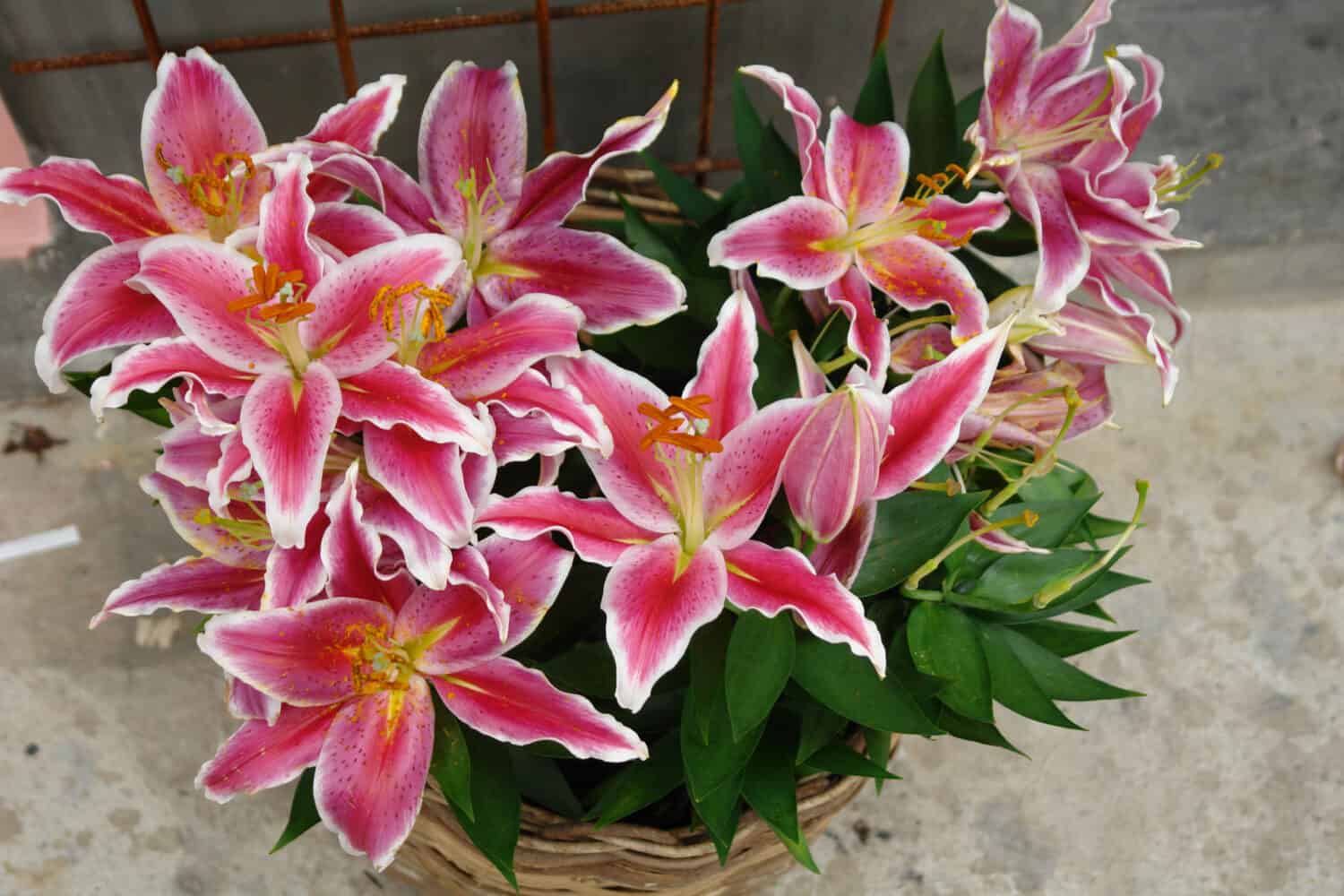
The large flowers of the oriental lily can add some elegance to the garden.
©ahmydaria/Shutterstock.com
Oriental lilies are known for their large, fragrant flowers and include varieties that bloom in captivating shades of pink. These perennial plants can reach heights of 3 to 5 feet, adding a touch of elegance and color to gardens. Oriental lilies prefer well-drained soil and full sun to partial shade, and regular watering is crucial to keep the soil moist.
Petunia (Petunia)
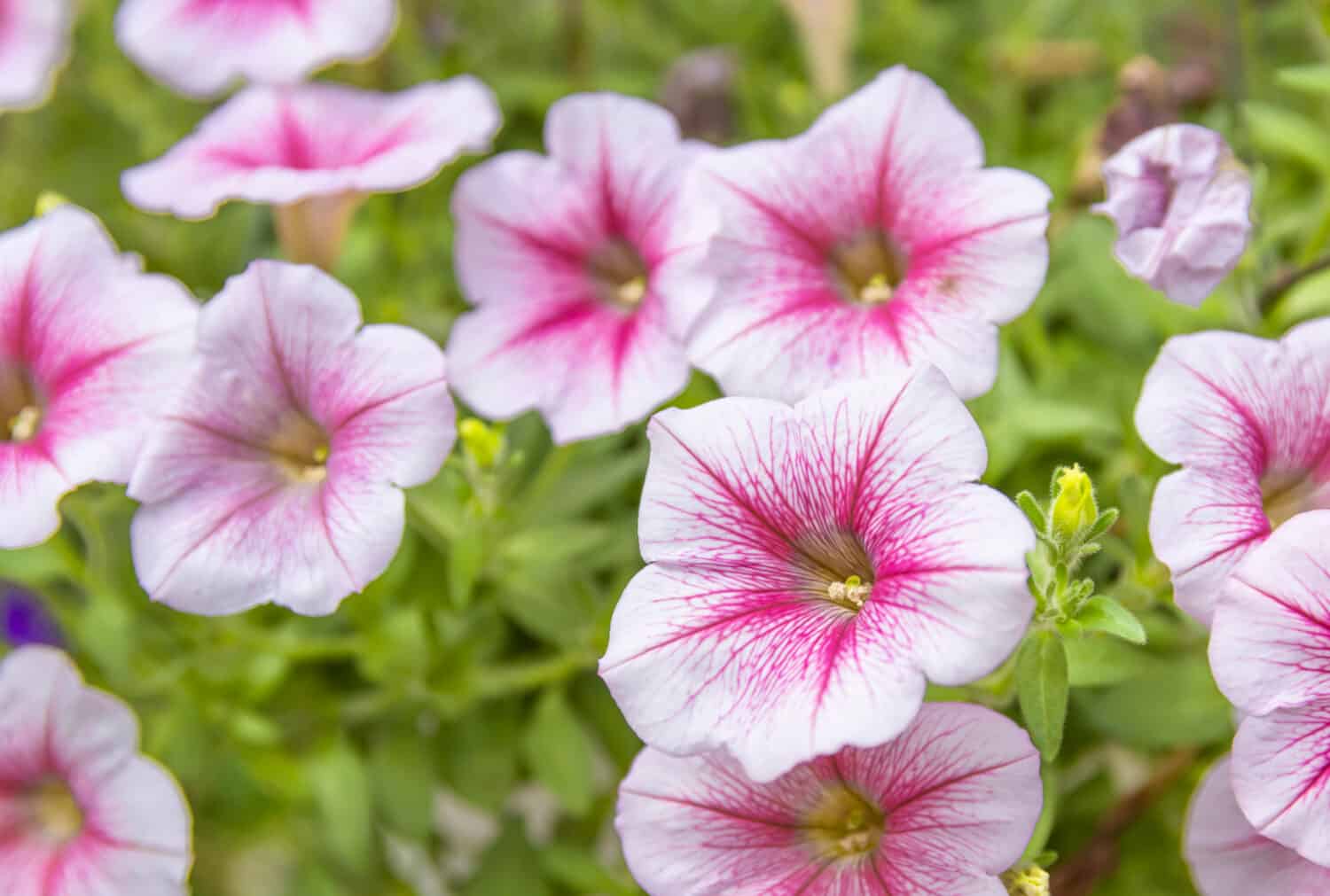
An adorable addition to any garden, the petunia is an annual plant.
©aomnet7/Shutterstock.com
Petunias, available in a wide range of pink hues, are versatile annual plants that create cascades of colorful blooms. They vary in size, from small to trailing varieties that can spread up to several feet. Petunias thrive in well-drained soil and full sun, requiring regular watering and deadheading to bloom throughout the season.
Camellia (Camellia)
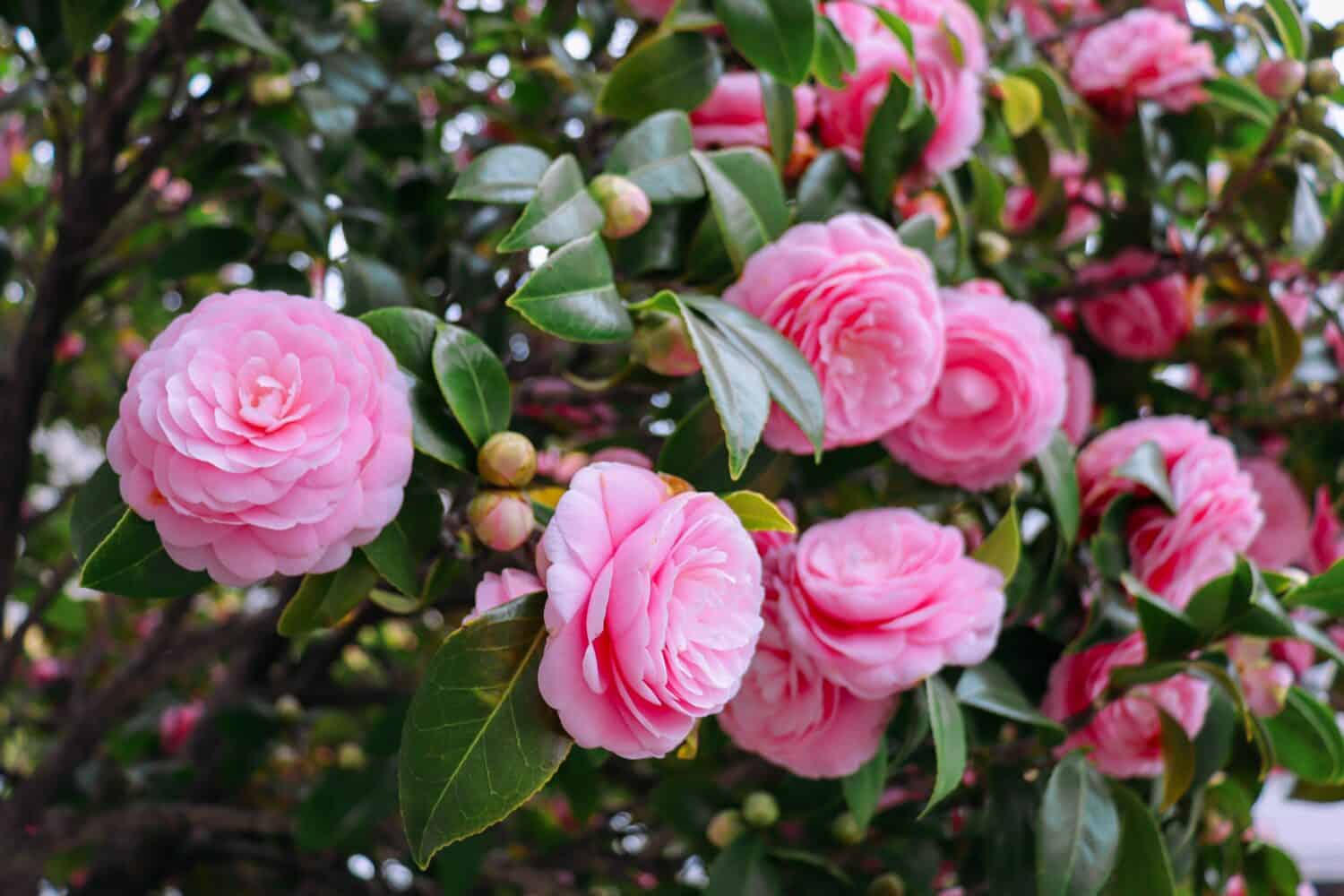
Camellias are shrubs or small trees that have beautiful pink blossoms.
©Alina_Miyazaki/Shutterstock.com
With their striking pink blooms, camellias are evergreen shrubs or small trees that can grow up to 6 to 12 feet. They feature glossy, dark green leaves and produce flowers that vary in size and shape. Camellias thrive in well-drained soil and prefer partial shade, requiring regular watering and mulching to maintain soil moisture.
Peony (Paeonia)
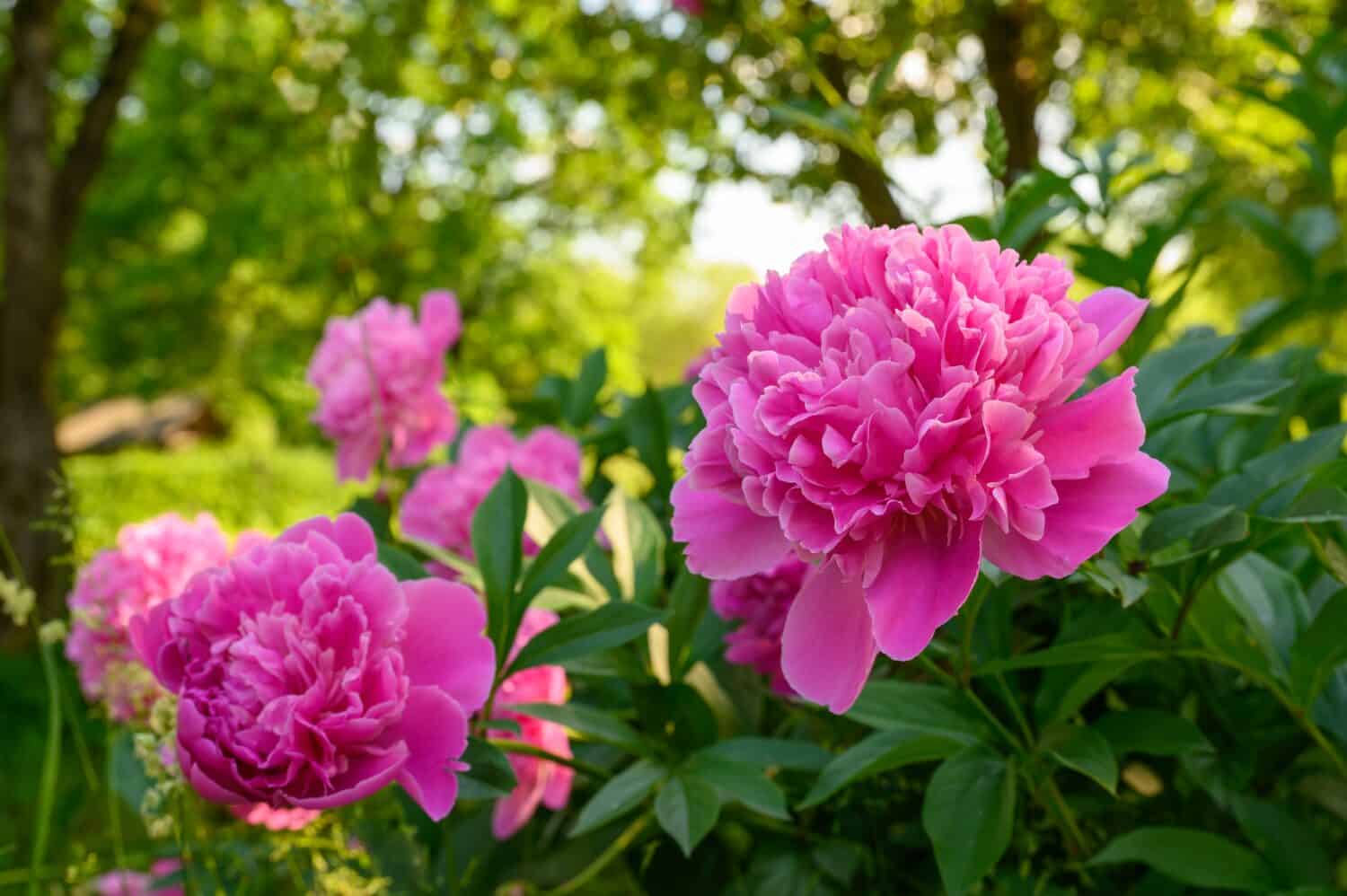
The fragrant flowers of the peony make it a popular plant.
©MTalvik/Shutterstock.com
Peonies, cherished for their fragrant pink flowers, are herbaceous perennials growing up to 3 feet tall. Their bushy foliage serves as a backdrop for the blooms. These flowers are often considered a symbol of beauty, grace, and prosperity, making them a beloved choice for gardens and floral arrangements. Peonies prefer well-drained soil and partial shade to full sun, needing regular watering and occasional staking to support their heavy flowers.
Aster (Aster)
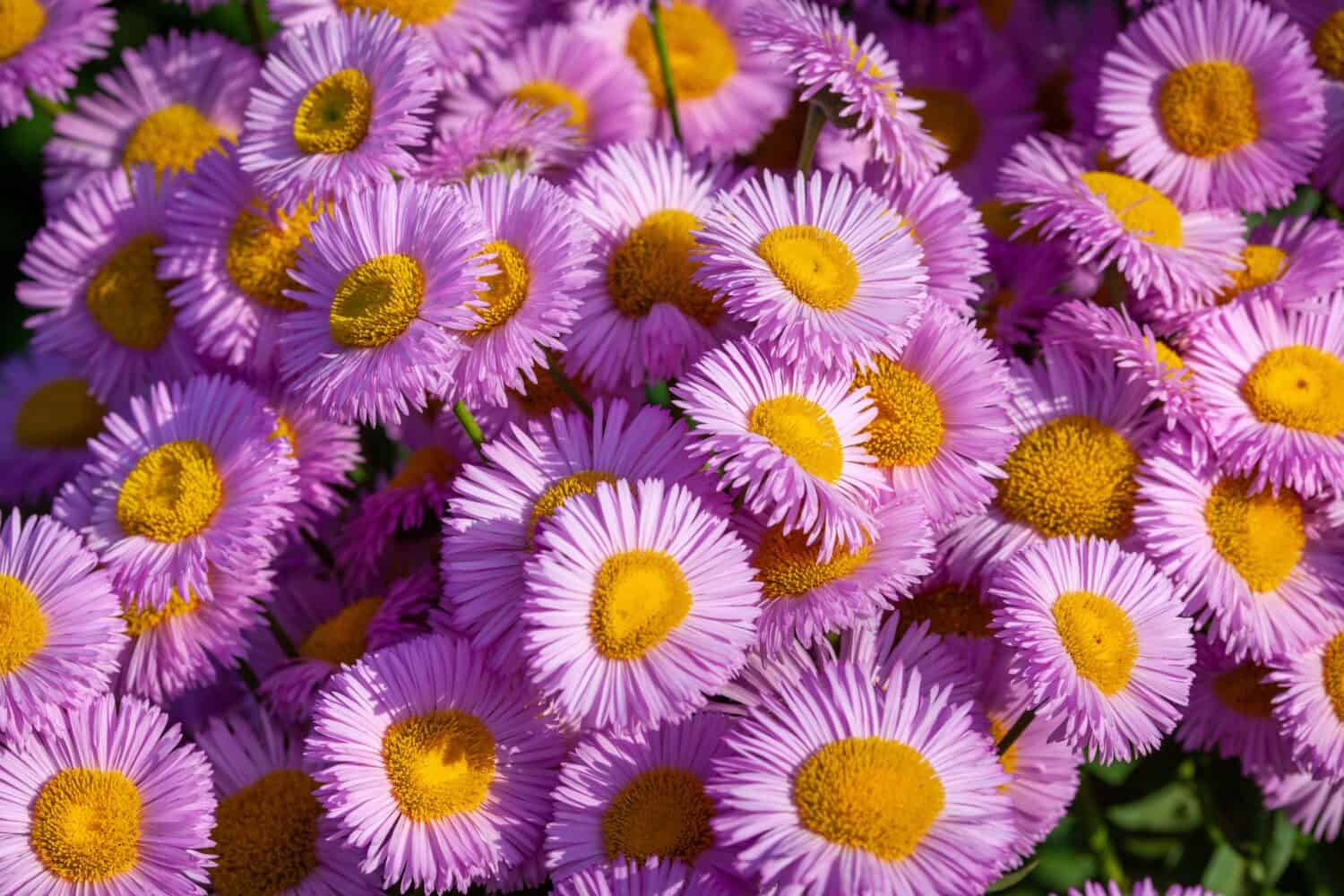
A perennial, asters produce flowers that look similar to daisies.
©Klever_ok/Shutterstock.com
Asters are perennials with pink daisy-like flowers that come in various sizes depending on the species, ranging from mounds to plants reaching 3 feet tall. They display a profusion of small, vibrant pink flowers that attract pollinators. Asters thrive in well-drained soil and prefer full sun, requiring regular watering and deadheading to encourage continuous blooming.
Foxglove (Digitalis)
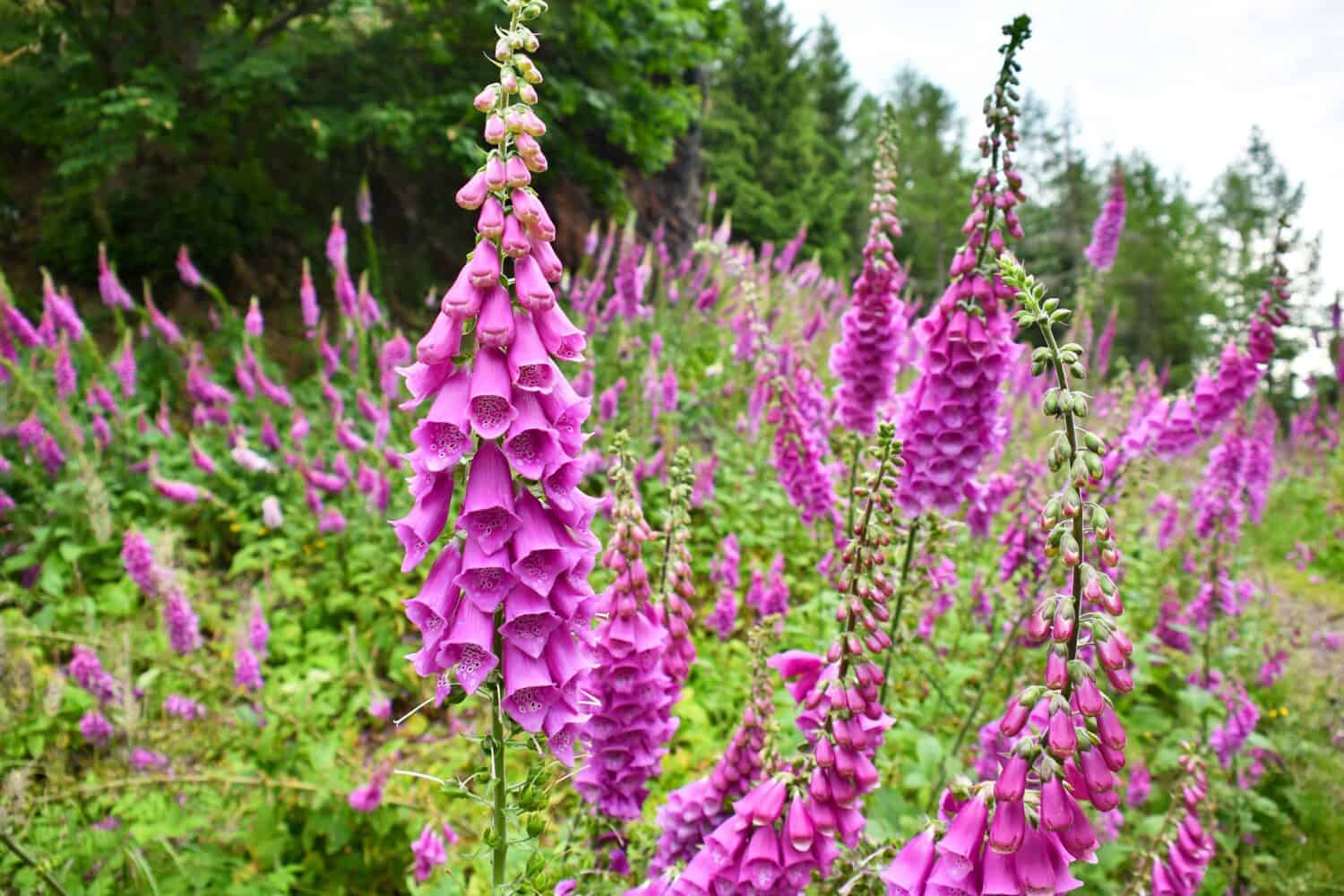
With their signature fuzzy foliage, foxgloves are tall plants.
©HAL-9000/Shutterstock.com
Foxgloves, tall biennial plants, showcase beautiful spires of tubular pink flowers. They can reach heights of 3 to 6 feet and have fuzzy foliage. Foxgloves prefer partial shade and moist, well-drained soil, requiring regular watering and staking to support their tall flower spikes. Unfortunately, foxgloves are also known for their potential toxicity, as all parts of the plant contain compounds that can be harmful if ingested, so it’s important to handle them with care, especially around children and pets.
Carnation (Dianthus caryophyllus)
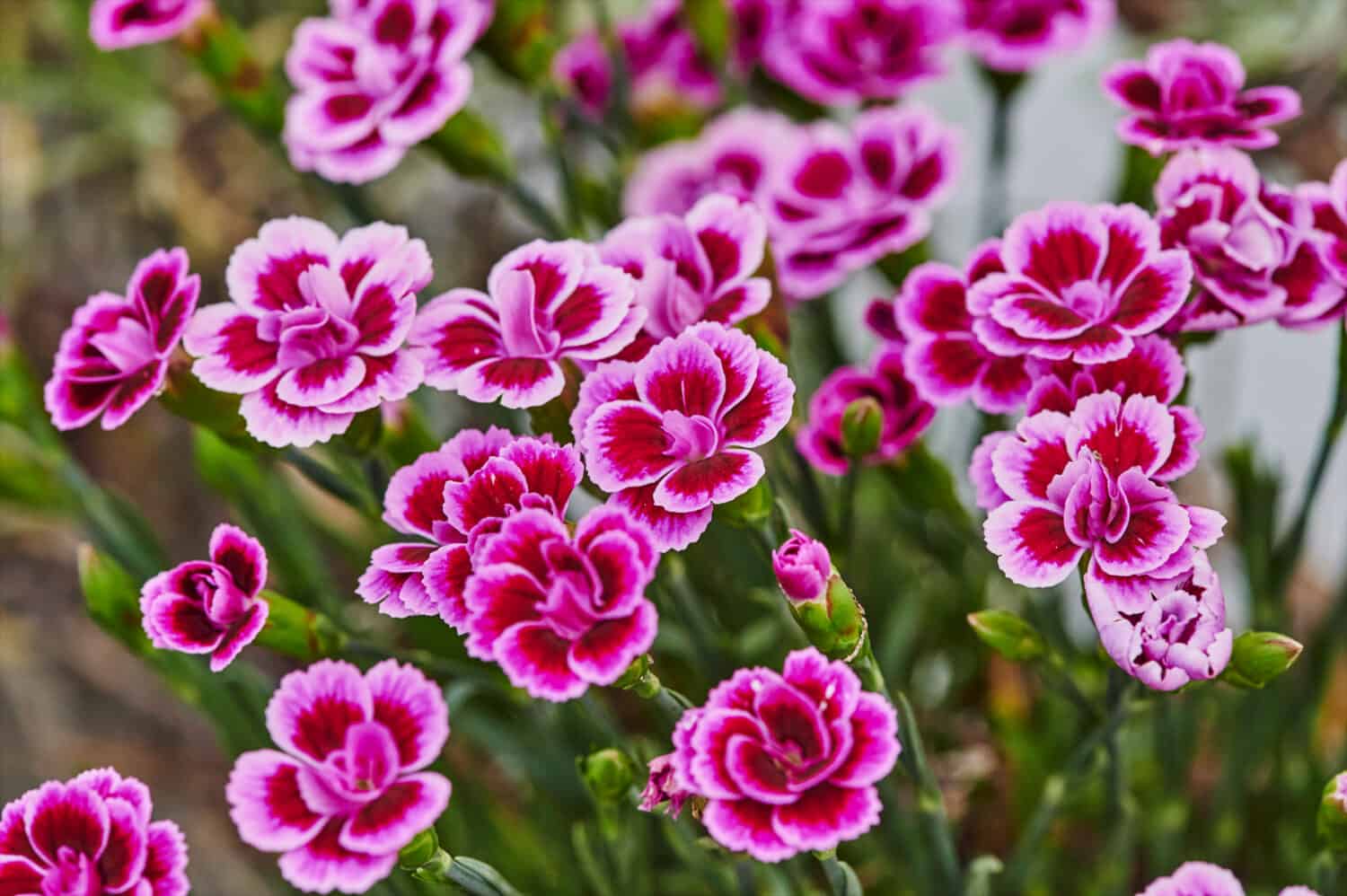
The vibrant flowers of the carnations have ruffled petals.
©Mickis-Fotowelt/Shutterstock.com
Carnations are perennial plants that come in various sizes and forms, including dwarf, medium, and tall varieties. They produce clusters of charming flowers with ruffled petals. Carnations prefer well-drained soil and full sun, requiring regular watering and deadheading to promote continuous blooming.
Begonia (Begonia)
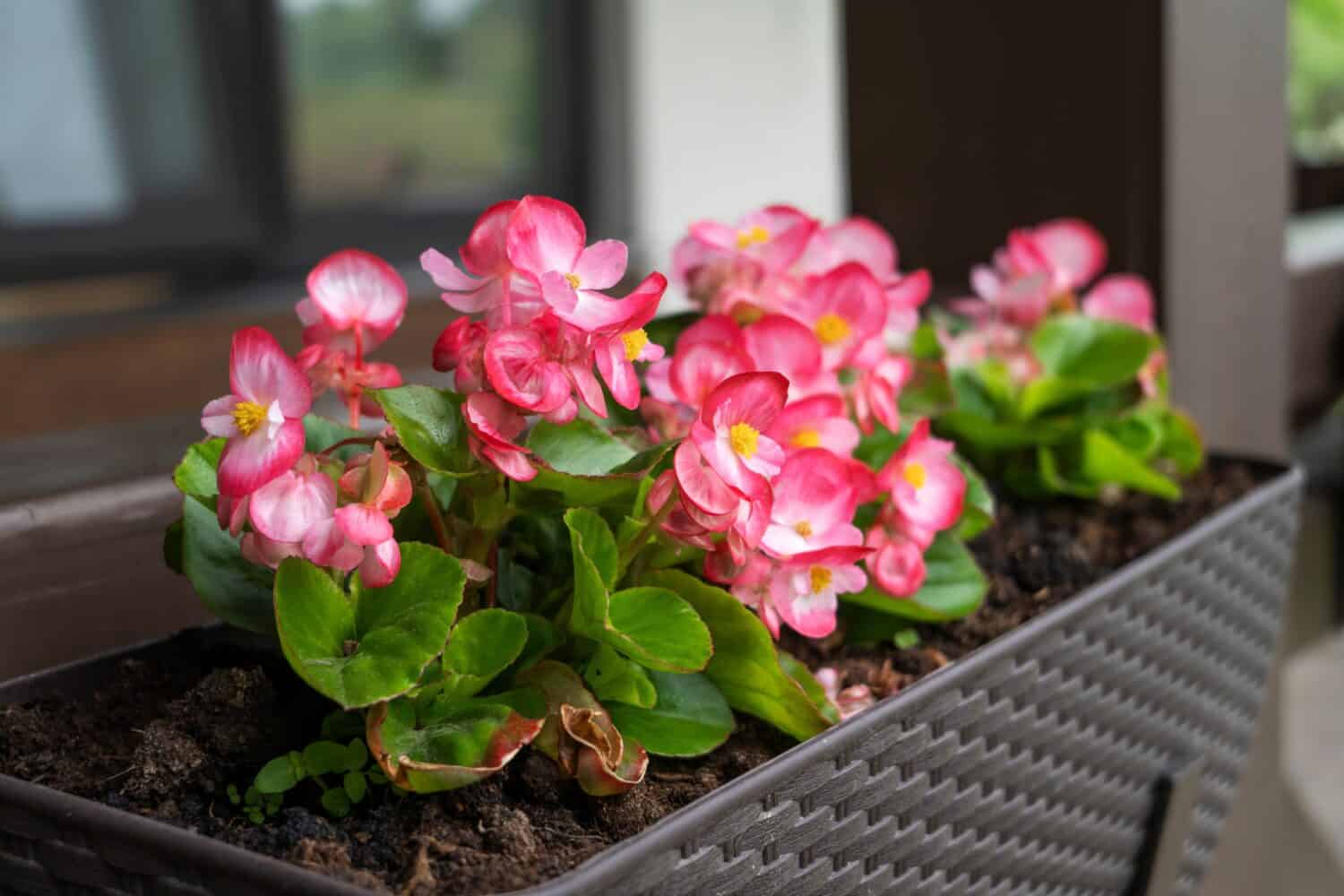
Coming in various sizes, begonias also come in a range of pink colors.
©IRINA CHETVERIKOVA/Shutterstock.com
Begonias, available in a range of pink shades, are versatile annual or perennial plants. They can vary in size, from compact varieties you may plant in pots and garden beds to larger ones that reach heights of approximately 1 to 2 feet. Begonias thrive in well-drained soil and prefer partial shade, requiring regular watering and occasional fertilizing for optimal growth and abundant pink blooming.
Geranium (Geranium)
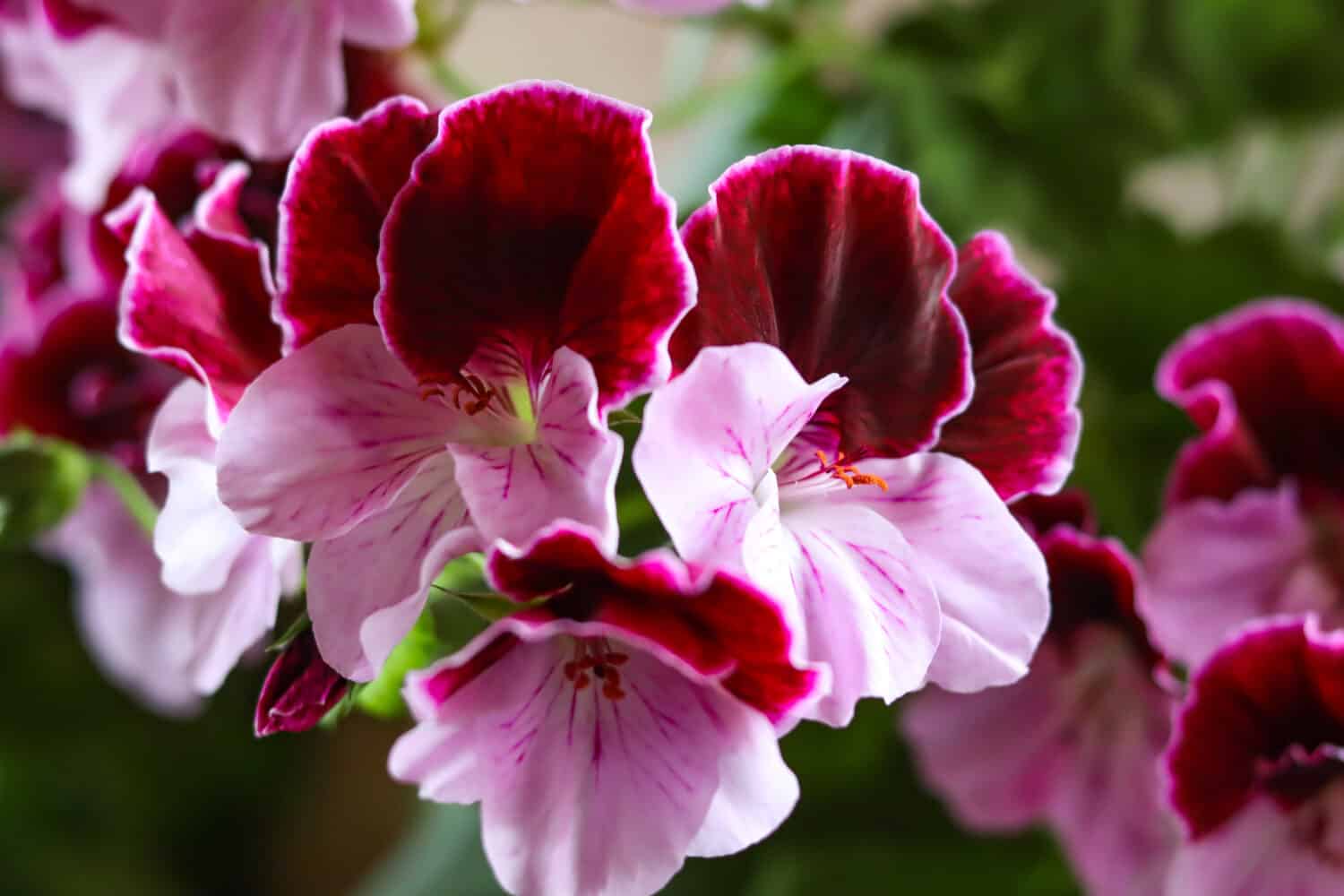
With a preference for well-drained soil and full sun to partial shade, geraniums need constant maintenance.
©Studio Photo MH/Shutterstock.com
Geraniums are herbaceous perennials with various growth habits and sizes depending on the plant. They can range from small mounds to sprawling or trailing plants. Geraniums prefer well-drained soil and full sun to partial shade, needing regular watering and deadheading to promote continuous blooming and maintain their tidy appearance.
Hollyhock (Alcea)
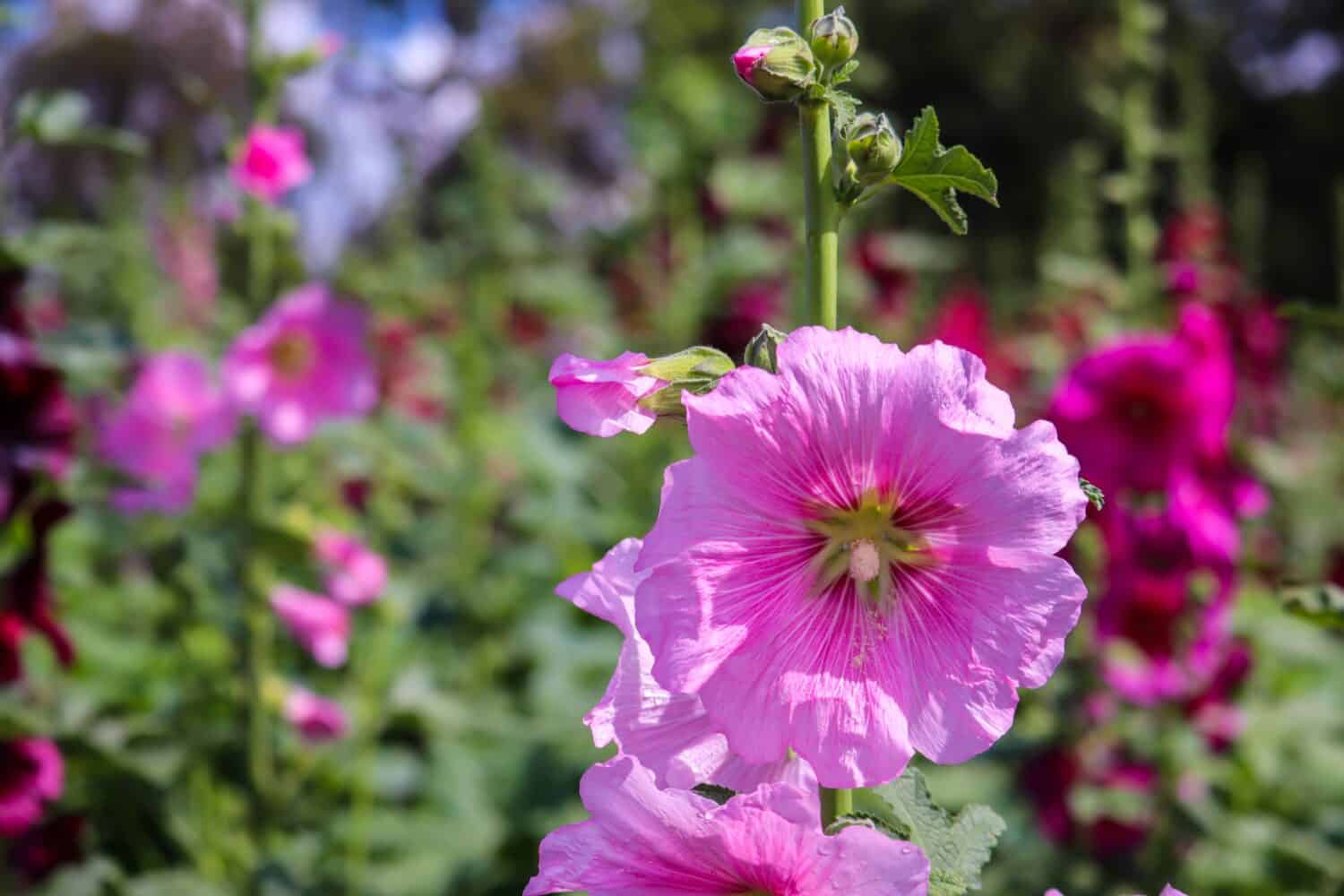
The spires of pink blooms of the hollyhock stand tall at 6 to 8 feet.
©Akarat Duangkhong/Shutterstock.com
Hollyhocks, stately biennial or perennial plants, boast tall spires of pink flowers that can reach heights of 6 to 8 feet. They have attractive leaves and produce abundant blooms along their vertical stems. Hollyhocks prefer well-drained soil and full sun, requiring regular watering and staking to support their height and prevent toppling.
Yarrow (Achillea millefolium)
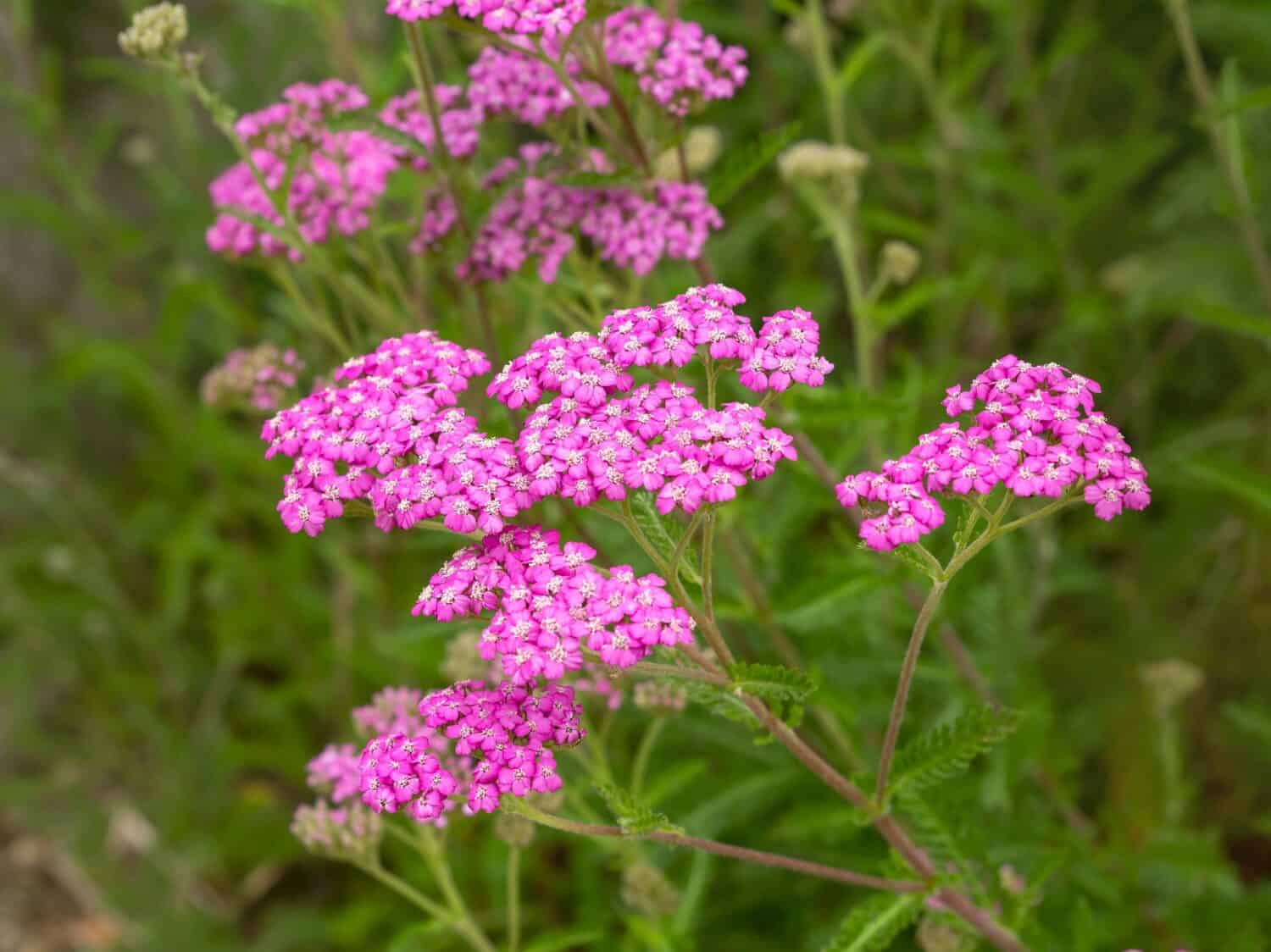
The clusters of flowers of the yarrow come in shades of pink.
©AngieC333/Shutterstock.com
Yarrows are hardy perennials with clusters of pink flowers and are known for their feathery, fern-like foliage. They typically reach heights of 1 to 3 feet and produce flat-topped flower clusters that can come in various shades of pink. Yarrows thrive in well-drained soil and full sun, requiring minimal watering once established and benefiting from occasional deadheading to encourage more blooming.
Fuchsia (Fuchsia)
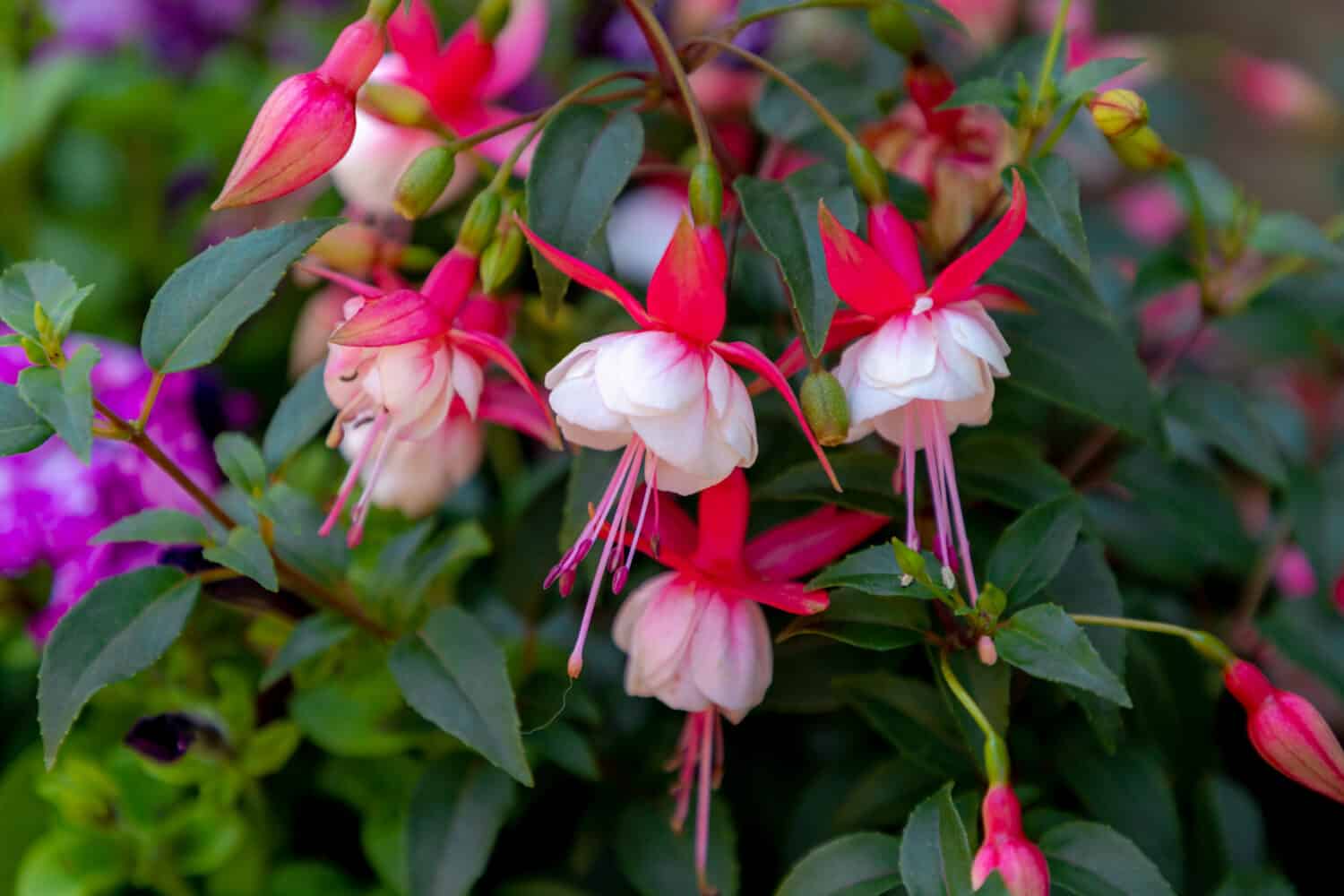
Varying in sizes, fuchsias are famous for their beautiful pink and red blooms.
©Wut_Moppie/Shutterstock.com
Fuchsias are cultivated flowering plants that can grow as shrubs, trailing vines, or upright varieties. They vary in size, from compact plants to larger ones that can reach several feet tall. Fuchsias prefer well-drained soil and partial shade, requiring regular watering and occasional pruning to maintain their shape and encourage prolific blooming.
Mandevilla (Mandevilla)
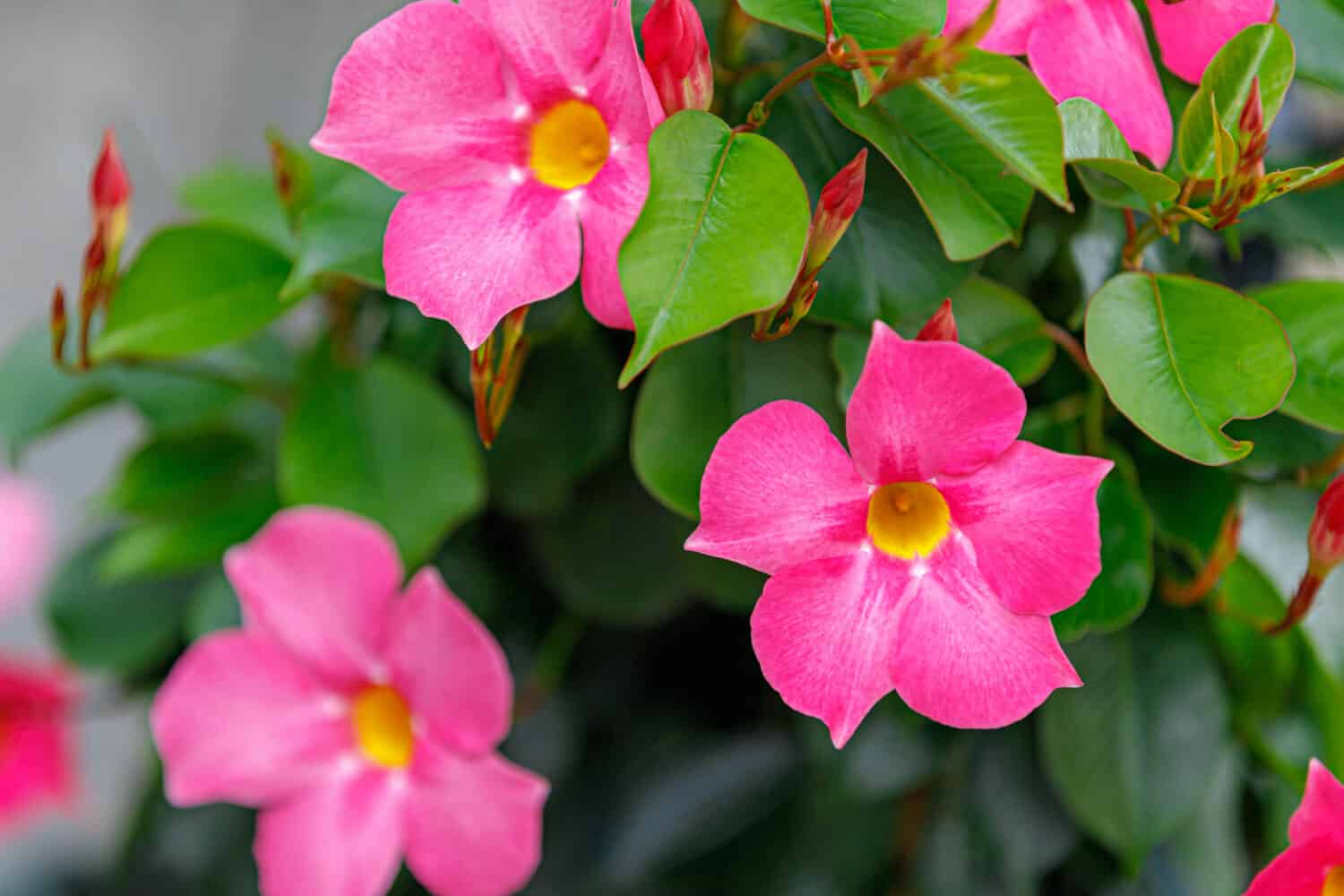
With trumpet-like flowers, the mandevilla can grow up to an incredible 8 feet tall!
©Wut_Moppie/Shutterstock.com
Mandevilla is a tropical vine that produces stunning pink flowers with a trumpet-like shape. It can grow up to 8 feet tall and displays glossy green leaves that provide a backdrop for vibrant blooms. Mandevilla grows best in full sun and well-drained soil, requiring regular watering and a trellis or support for climbing.
Creeping Phlox (Phlox stolonifera)
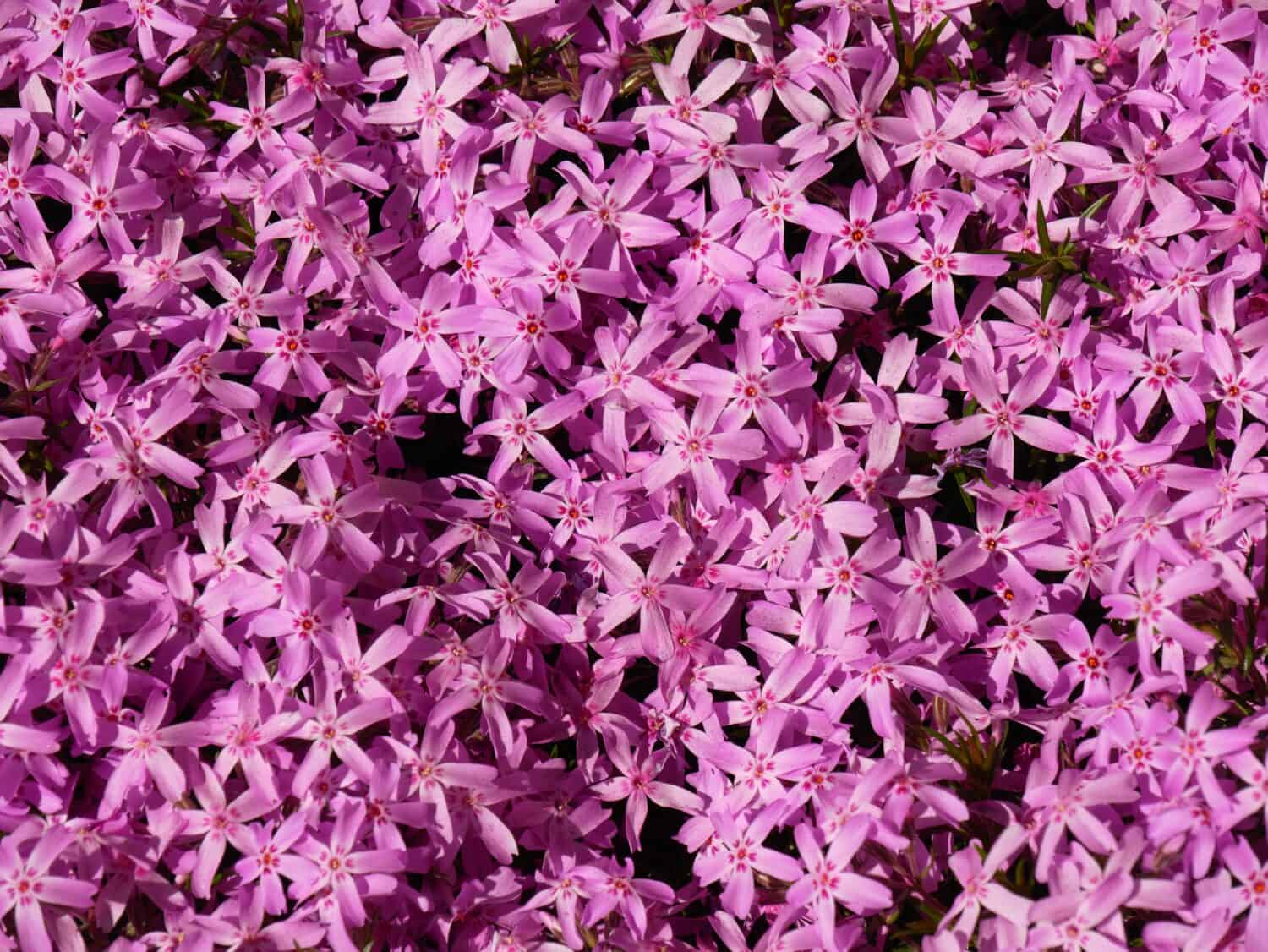
As the name suggests, the creeping phlox forms a dense carpet on the ground.
©Batest/Shutterstock.com
Creeping phlox, a low-growing perennial, forms a dense pink flower carpet, creating a beautiful ground cover. It typically grows up to 6 inches in height and spreads up to 2 feet wide. Creeping phlox prefers full sun and well-drained soil, requiring regular watering and occasional pruning to maintain its compact shape.
Hibiscus (Hibiscus)
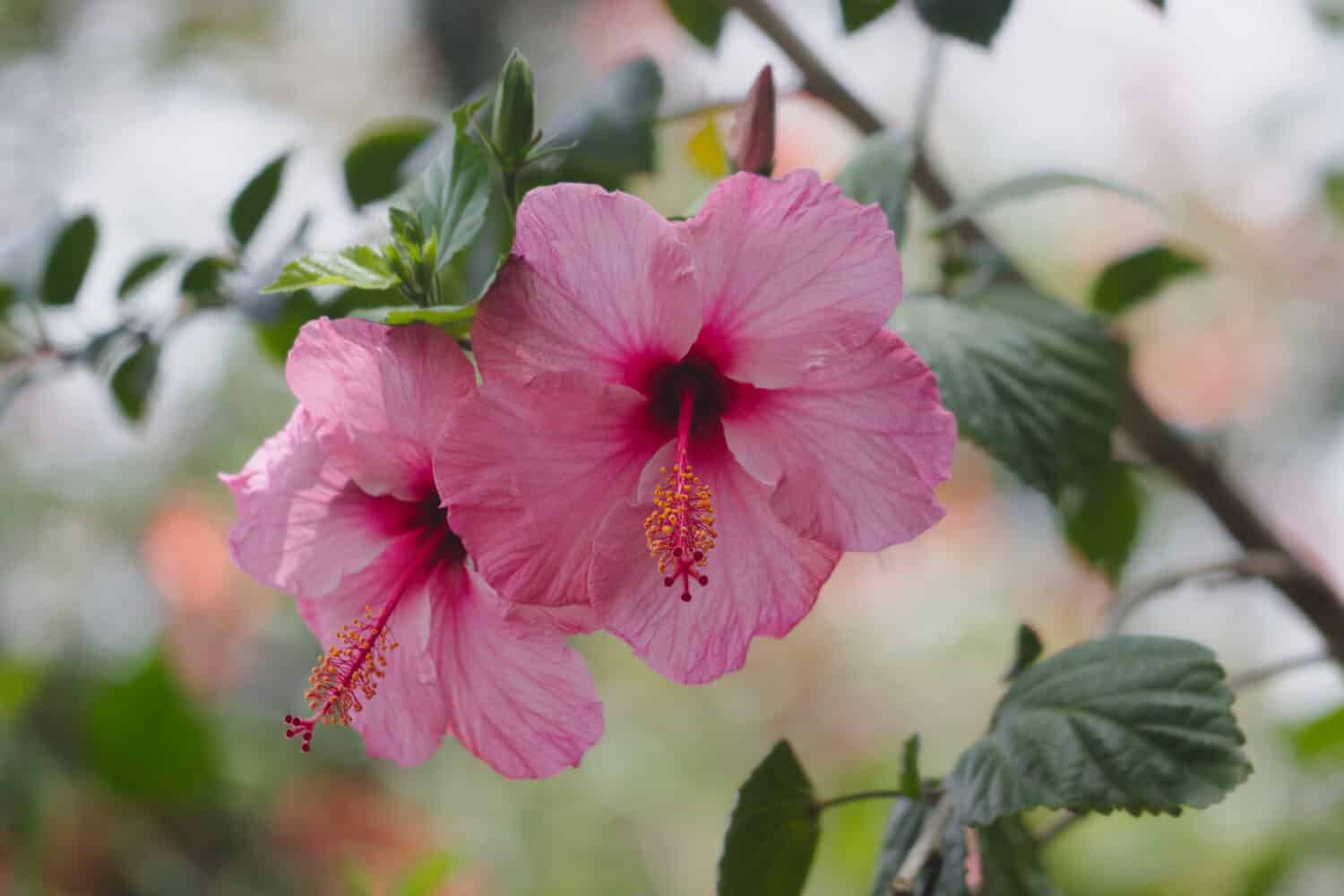
The large and beautiful flowers of the hibiscus plant provide a striking appearance in any garden.
©Cadurn/Shutterstock.com
Hibiscus is a tropical shrub that showcases large, showy pink flowers with a striking appearance. It can reach heights of 6 to 15 feet, depending on the variety. The flowers are not only visually stunning but also attract pollinators such as butterflies and hummingbirds, adding an extra touch of liveliness to any garden. Hibiscus thrives in full sun and well-drained soil, requiring regular watering and fertilizing to promote healthy growth and abundant blooms.
Turtlehead (Chelone)
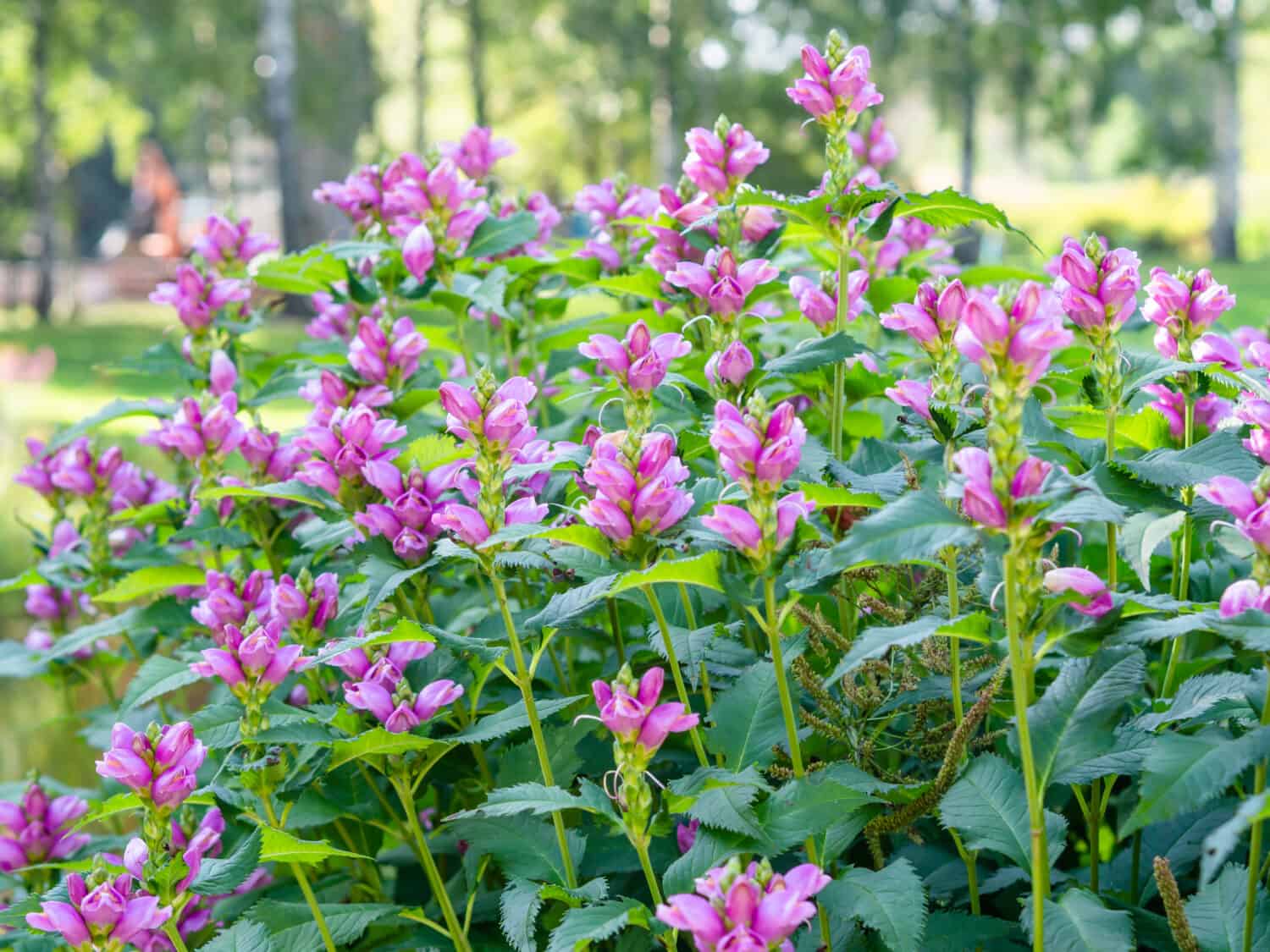
Resembling a turtle’s head, the blooms of the turtlehead are pink in color.
©mcajan/Shutterstock.com
A perennial plant, turtleheads produce lovely pink flowers that resemble the shape of a turtle’s head, hence its name. It grows to 2 to 3 feet and displays attractive lance-shaped leaves. Turtleheads thrive in partial shade and moist, well-drained soil. They also require regular watering and occasional division to maintain their vigor and promote blooming.
Snapdragon (Antirrhinum)
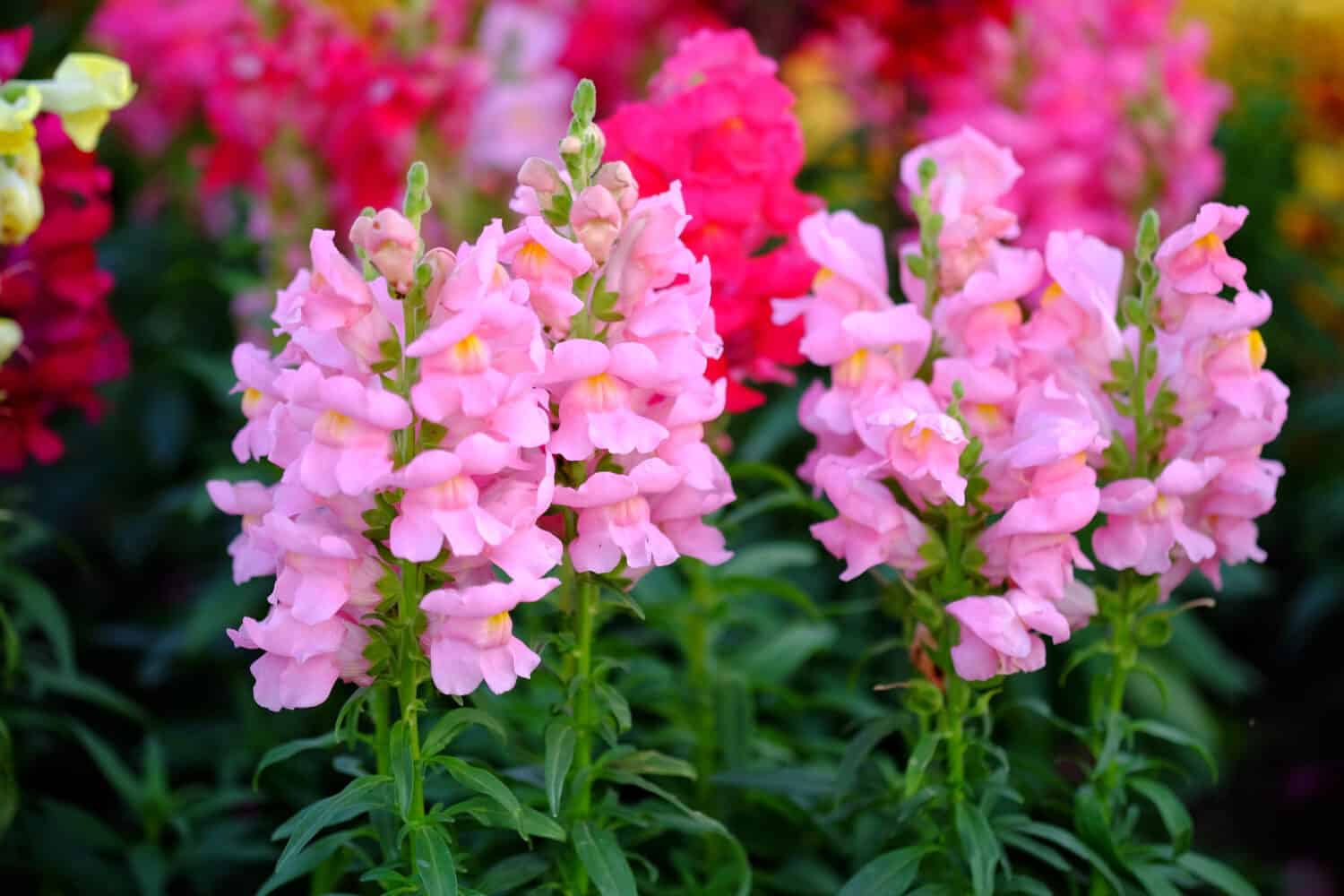
Coming in various shades of pink, snapdragons also range in size.
©Nualanong/Shutterstock.com
Snapdragons are charming annual or perennial plants with spiky blooms that come in various shades of pink. They range in size from dwarf varieties that reach around 6 inches tall to taller types that can grow up to 3 feet. Snapdragons prefer full sun and well-drained soil. Further, they need regular watering and the removal of older blooms to encourage continuous blooming throughout their season.
Swamp Lily (Crinum powellii)
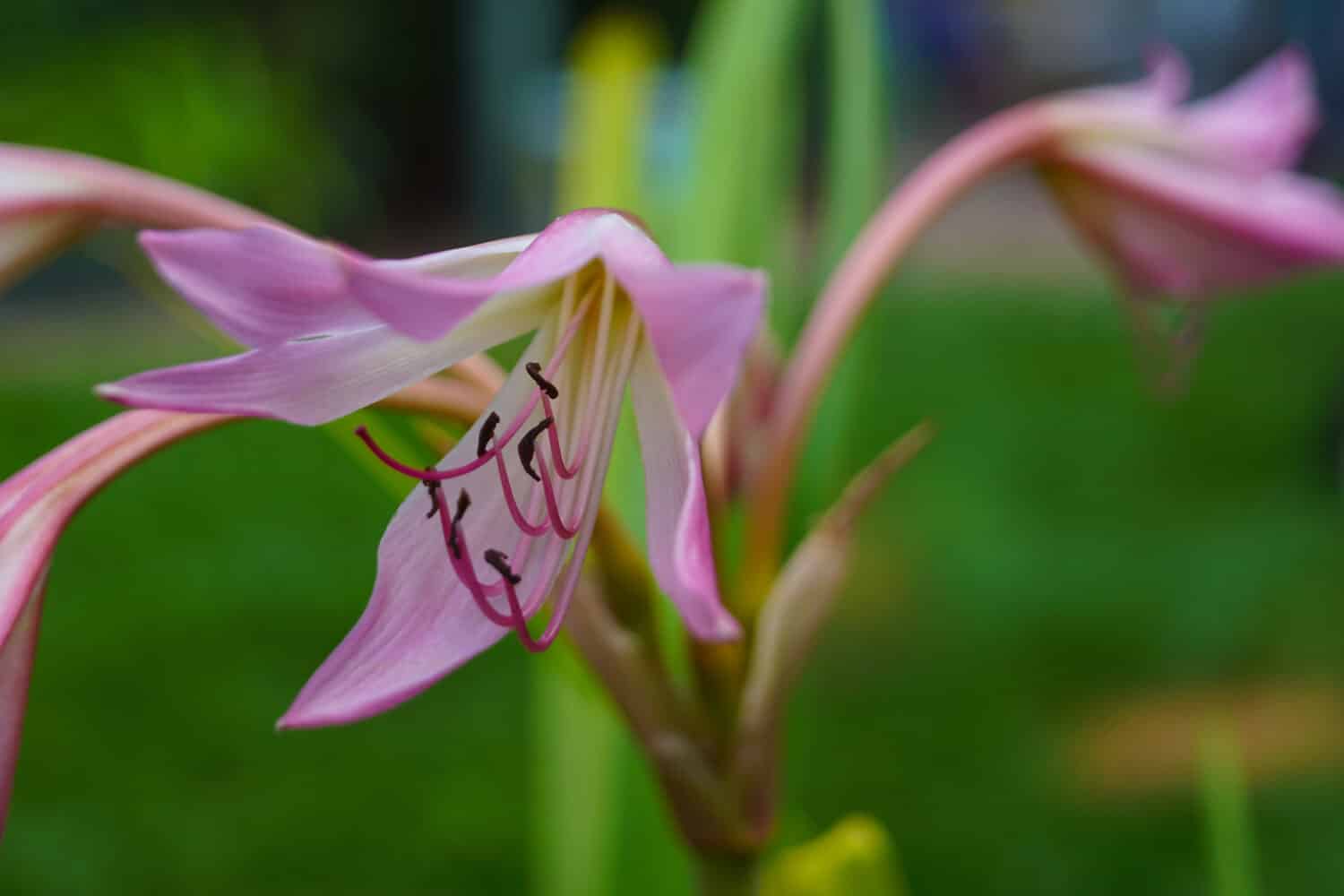
Spider lilies have pink trumpet-like flowers.
©Natalia van D/Shutterstock.com
A fragrant plant, spider lily is a perennial with large trumpet-like flowers that are light pink in color. These flowers typically bloom in the late summer to fall months. The flowers are 5 inches wide, and the plant itself grows between 3 to 5 feet tall. Spider lilies perform at their best with full sun and well-drained but moist soil.
Summary of the 30 Plants with Breathtaking Pink Flowers
| Common Name | Scientific Name |
|---|---|
| Coral Bells | Heuchera |
| Impatiens | Impatiens |
| Lupine | Lupinus |
| Hyssop | Hyssopus officinalis |
| Dahlia | Dahlia |
| Campion | Silene |
| Chrysanthemum | Chrysanthemum |
| Astilbe | Astilbe |
| Zinnia | Zinnia |
| Anemone | Anemone coronaria |
| Tulips | Tulipa |
| Cherry Blossom | Prunus serrulata |
| Oriental Lily | Lilium orientalis |
| Petunia | Petunia |
| Camellia | Camellia |
| Peonies | Paeonia |
| Aster | Aster |
| Foxglove | Digitalis |
| Carnation | Dianthus caryophyllus |
| Begonia | Begonia |
| Geranium | Geranium |
| Hollyhock | Alcea |
| Yarrow | Achillea millefolium |
| Fuchsia | Fuchsia |
| Mandevilla | Mandevilla |
| Creeping phlox | Phlox stolonifera |
| Hibiscus | Hibiscus |
| Turtlehead | Chelone |
| Snapdragon | Antirrhinum |
| Swamp lily | Crinum powellii |
The photo featured at the top of this post is © StopperOhana/Shutterstock.com
Thank you for reading! Have some feedback for us? Contact the AZ Animals editorial team.






